Paul van Yperen's Blog, page 440
October 24, 2013
Til Schweiger
Handsome actor, director, and producer Til Schweiger (1963) is one of Germany's most successful filmmakers. Since 1990, no other German actor has drawn more people to the cinemas.
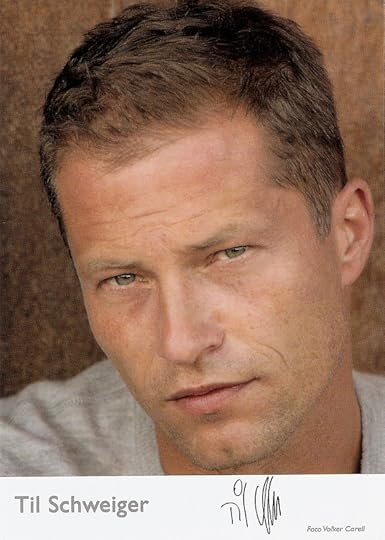
German postcard. Photo: Volker Corell.
Hunky Object Of Desire
Tilman Valentin ‘Til’ Schweiger was born in Freiburg, West Germany, in 1963. His parents were both teachers. He grew up with his two brothers in Heuchelheim near Giessen in Hesse, where he went to school.
First, he studied German and Medicine at the University, but in 1986 he chose for acting lessons at the drama school Der Keller in Cologne. After graduation in 1989, he played at several theaters in Cologne and Bonn. He first appeared onscreen in the TV series Lindenstraße (1989-1992). His first film role came with Manta, Manta/Racin' in the Street (Wolfgang Büld, 1991).
His international breakthrough followed with the comedy Der bewegte Mann/Maybe, Maybe Not (Sönke Wortmann, 1994), co-starring Joachim Król and Katja Riemann. Schweiger was a sensation as the hunky object of desire for both the women and the men in the film.
Der bewegte Mann was developed from the gay comics Der bewegte Mann and Pretty Baby by underground cartoonist Ralf König. With 6.5 million visitors in Germany, the film was the third biggest box office hit of the year in Germany. It also won several awards in Germany, including the German media award Bambi.
In 1995, Schweiger married American model Dana Carlson. The couple has four children: Valentin Florian Schweiger (1995), Luna Marie Schweiger (1997), Lilli Camille Schweiger (1998), and Emma Tiger Schweiger (2002).
His next film, Männerpension/Jailbirds (Detlev Buck, 1996) was again loaded with prizes, including a Bambi and a Jupiter as Best German film of the Year, and a Goldene Leinwand (Golden Screen) for its results at the German box offices.
In 1997, Schweiger made his debut as a producer and (uncredited) co-director with the crime comedy Knockin' on Heaven's Door (Thomas Jahn, 1997). The film is about two young terminal cancer patients (Jan Josef Liefers and Schweiger) who decide to take one last trip to the sea. However, the car they've stolen belongs to two thieves and contains a million marks. Soon they're being pursued by both thugs and cops. Knockin' on Heaven's Door became a cult favourite among cinema audiences worldwide.
Next, Schweiger directed, produced and starred in the action thriller Der Eisbär/The Polar Bear (Granz Henman, Til Schweiger, 1998).
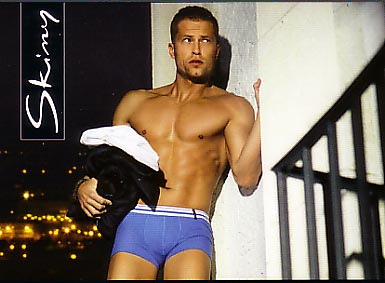
Promotion card for Skiny. Source: Til schweiger @ Flickr.
Big-budget Action Flops
Til Schweiger made his American acting debut in the crime thriller Judas Kiss (Sebastian Gutierrez, 1998), starring Alan Rickman and Emma Thompson.
It was followed by supporting parts in productions like the action films The Replacement Killers (Antoine Fuqua, 1998) starring Chow Yun-fat and Mira Sorvino, and Driven (Renny Harlin, 2001), starring Sylvester Stallone. Both were disappointing box office flops.
Smaller films were SLC Punk! (James Merendino, 1998) and the TV movie Joe and Max (Steve James, 2002), based on the legendary 1936 boxing fight of African-American heavyweight Joe Louis (Leonard Roberts) vs. German counterpart Max Schmeling (Schweiger), and Schmeling's secret heroism during World War II.
Like his earlier big-budget action films, Lara Croft Tomb Raider: The Cradle of Life (Jan de Bont, 2003), starring Angelina Jolie as Lara Croft, was another box office disappointment.
Next he played supporting parts in King Arthur (Antoine Fuqua, 2004) featuring Clive Owen, the World War II submarine film In Enemy Hands/U-Boat (Tony Giglio, 2004), starring William H. Macy, and as Lucky Luke in the French Western comedy Les Dalton/The Daltons (Philippe Haïm, 2004), based on the popular comic by Morris. I
n Germany, he appeared in (T)Raumschiff Surprise – Periode 1/Dreamship Surprise (Michael Herbig, 2004) in which several Star Trek and Star Wars characters are parodied. The Science Fiction satire draw 9.2 million visitors in Germany and was his most popular German production ever.
In 2005, Schweiger and his wife Dana Carlson separated, but they never divorced. Since 2010, Schweiger has been in a relationship with model Svenja Holtmann.
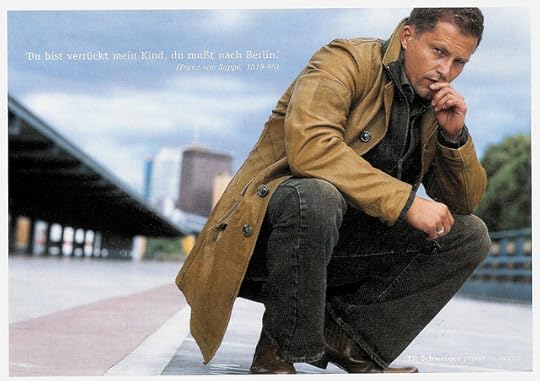
German postcard by Peek & Cloppenburg.
Back To Berlin
After the separation from his wife Dana, Til Schweiger moved to Berlin and started his own production company, Barefoot Films. He wrote, directed, and starred in the romantic comedy Barfuß/Barefoot (2005), which won the Bambi award as the Best German Film of 2005.
His next production, Keinohrhasen/Rabbit Without Ears (2007), which he wrote, directed, starred in and produced, was a surprise hit in Germany. With a box office result of USD 74,000,000, the romantic comedy, co-starring Nora Tschirner, became one of the most successful films in German theatres ever. The film won a Bambi, a Bavarian Film Award, the German Comedy Award, two DIVA Awards, a Jupiter Award and the Ernst Lubitsch Award.
The sequel, Zweiohrküken/Rabbit Without Ears 2 (2008) was also a huge success. Schweiger then went on to direct, produce and star in 1½ Ritter – Auf der Suche nach der hinreißenden Herzelinde/1½ Knights – In Search of the Ravishing Princess Herzelinde (2008), which was slashed by the critics, but also proved to be another cinema hit.
In Kokowääh (2011), Schweiger's daughter Emma stars beside him, and the film is also directed, co-written and produced by him. Kokowääh (referring to Coq au vin) received better reviews and was another popular success. Father and daughter reprised their roles in the sequel Kokowääh 2 (2013).
Besides in his own films, Schweiger also played in many other films. He was unforgettable as the steely psychopath Sgt. Hugo Stiglitz, infamous for his brutal and sadistic ways of murdering Nazis in Quentin Tarantino's Inglourious Basterds (2009).
His recent international screen appearances were in the romantic comedy New Year's Eve (Garry Marshall, 2011), the action film The Courier (Hany Abu-Assad, 2011) with Mickey Rourke, and as an international criminal in the romantic spy comedy This Means War (McG, 2012), with Chris Pine and Reese Witherspoon. He can also be seen in Muppets Most Wanted (James Bobin, 2014).
According to the website Inside Kino , no other German actor has more star power, has drawn more people to the international cinemas since 1990, than Til Schweiger.
German trailer Der bewegte Mann (1994). Source: Kilkenny1978 (YouTube).
Trailer Knockin' on Heaven's Door (1997). Source: MrBrownEntertainment (YouTube).
Sources: AllMovie, Inside Kino, Wikipedia and .

German postcard. Photo: Volker Corell.
Hunky Object Of Desire
Tilman Valentin ‘Til’ Schweiger was born in Freiburg, West Germany, in 1963. His parents were both teachers. He grew up with his two brothers in Heuchelheim near Giessen in Hesse, where he went to school.
First, he studied German and Medicine at the University, but in 1986 he chose for acting lessons at the drama school Der Keller in Cologne. After graduation in 1989, he played at several theaters in Cologne and Bonn. He first appeared onscreen in the TV series Lindenstraße (1989-1992). His first film role came with Manta, Manta/Racin' in the Street (Wolfgang Büld, 1991).
His international breakthrough followed with the comedy Der bewegte Mann/Maybe, Maybe Not (Sönke Wortmann, 1994), co-starring Joachim Król and Katja Riemann. Schweiger was a sensation as the hunky object of desire for both the women and the men in the film.
Der bewegte Mann was developed from the gay comics Der bewegte Mann and Pretty Baby by underground cartoonist Ralf König. With 6.5 million visitors in Germany, the film was the third biggest box office hit of the year in Germany. It also won several awards in Germany, including the German media award Bambi.
In 1995, Schweiger married American model Dana Carlson. The couple has four children: Valentin Florian Schweiger (1995), Luna Marie Schweiger (1997), Lilli Camille Schweiger (1998), and Emma Tiger Schweiger (2002).
His next film, Männerpension/Jailbirds (Detlev Buck, 1996) was again loaded with prizes, including a Bambi and a Jupiter as Best German film of the Year, and a Goldene Leinwand (Golden Screen) for its results at the German box offices.
In 1997, Schweiger made his debut as a producer and (uncredited) co-director with the crime comedy Knockin' on Heaven's Door (Thomas Jahn, 1997). The film is about two young terminal cancer patients (Jan Josef Liefers and Schweiger) who decide to take one last trip to the sea. However, the car they've stolen belongs to two thieves and contains a million marks. Soon they're being pursued by both thugs and cops. Knockin' on Heaven's Door became a cult favourite among cinema audiences worldwide.
Next, Schweiger directed, produced and starred in the action thriller Der Eisbär/The Polar Bear (Granz Henman, Til Schweiger, 1998).

Promotion card for Skiny. Source: Til schweiger @ Flickr.
Big-budget Action Flops
Til Schweiger made his American acting debut in the crime thriller Judas Kiss (Sebastian Gutierrez, 1998), starring Alan Rickman and Emma Thompson.
It was followed by supporting parts in productions like the action films The Replacement Killers (Antoine Fuqua, 1998) starring Chow Yun-fat and Mira Sorvino, and Driven (Renny Harlin, 2001), starring Sylvester Stallone. Both were disappointing box office flops.
Smaller films were SLC Punk! (James Merendino, 1998) and the TV movie Joe and Max (Steve James, 2002), based on the legendary 1936 boxing fight of African-American heavyweight Joe Louis (Leonard Roberts) vs. German counterpart Max Schmeling (Schweiger), and Schmeling's secret heroism during World War II.
Like his earlier big-budget action films, Lara Croft Tomb Raider: The Cradle of Life (Jan de Bont, 2003), starring Angelina Jolie as Lara Croft, was another box office disappointment.
Next he played supporting parts in King Arthur (Antoine Fuqua, 2004) featuring Clive Owen, the World War II submarine film In Enemy Hands/U-Boat (Tony Giglio, 2004), starring William H. Macy, and as Lucky Luke in the French Western comedy Les Dalton/The Daltons (Philippe Haïm, 2004), based on the popular comic by Morris. I
n Germany, he appeared in (T)Raumschiff Surprise – Periode 1/Dreamship Surprise (Michael Herbig, 2004) in which several Star Trek and Star Wars characters are parodied. The Science Fiction satire draw 9.2 million visitors in Germany and was his most popular German production ever.
In 2005, Schweiger and his wife Dana Carlson separated, but they never divorced. Since 2010, Schweiger has been in a relationship with model Svenja Holtmann.

German postcard by Peek & Cloppenburg.
Back To Berlin
After the separation from his wife Dana, Til Schweiger moved to Berlin and started his own production company, Barefoot Films. He wrote, directed, and starred in the romantic comedy Barfuß/Barefoot (2005), which won the Bambi award as the Best German Film of 2005.
His next production, Keinohrhasen/Rabbit Without Ears (2007), which he wrote, directed, starred in and produced, was a surprise hit in Germany. With a box office result of USD 74,000,000, the romantic comedy, co-starring Nora Tschirner, became one of the most successful films in German theatres ever. The film won a Bambi, a Bavarian Film Award, the German Comedy Award, two DIVA Awards, a Jupiter Award and the Ernst Lubitsch Award.
The sequel, Zweiohrküken/Rabbit Without Ears 2 (2008) was also a huge success. Schweiger then went on to direct, produce and star in 1½ Ritter – Auf der Suche nach der hinreißenden Herzelinde/1½ Knights – In Search of the Ravishing Princess Herzelinde (2008), which was slashed by the critics, but also proved to be another cinema hit.
In Kokowääh (2011), Schweiger's daughter Emma stars beside him, and the film is also directed, co-written and produced by him. Kokowääh (referring to Coq au vin) received better reviews and was another popular success. Father and daughter reprised their roles in the sequel Kokowääh 2 (2013).
Besides in his own films, Schweiger also played in many other films. He was unforgettable as the steely psychopath Sgt. Hugo Stiglitz, infamous for his brutal and sadistic ways of murdering Nazis in Quentin Tarantino's Inglourious Basterds (2009).
His recent international screen appearances were in the romantic comedy New Year's Eve (Garry Marshall, 2011), the action film The Courier (Hany Abu-Assad, 2011) with Mickey Rourke, and as an international criminal in the romantic spy comedy This Means War (McG, 2012), with Chris Pine and Reese Witherspoon. He can also be seen in Muppets Most Wanted (James Bobin, 2014).
According to the website Inside Kino , no other German actor has more star power, has drawn more people to the international cinemas since 1990, than Til Schweiger.
German trailer Der bewegte Mann (1994). Source: Kilkenny1978 (YouTube).
Trailer Knockin' on Heaven's Door (1997). Source: MrBrownEntertainment (YouTube).
Sources: AllMovie, Inside Kino, Wikipedia and .
Published on October 24, 2013 23:00
October 23, 2013
Ugo Tognazzi
Ugo Tognazzi (1922-1990) was an Italian film, TV, and theatre actor, director, and screenwriter. During the 1960s and 1970s, he was one of the most renowned stars of the Commedia all'Italiana. He worked with such major directors as Marco Ferreri, Pier Paolo Pasolini, Luigi Comencini, Bernardo Bertolucci and Ettore Scola, but his greatest hit was the gay comedy La cage aux Folles (1978).
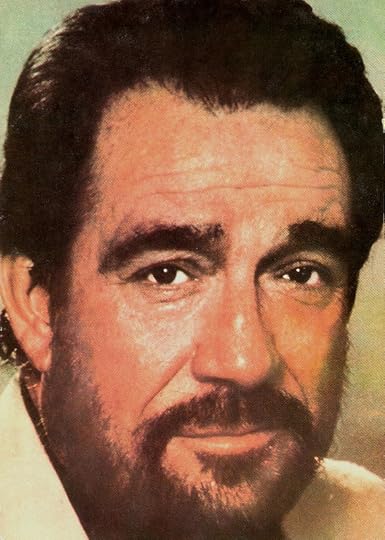
Romanian postcard by Casa Filmului Acin.
Successful TV Comedy Duo
Ugo Tognazzi was born Ottavio Tognazzi in 1922 in Cremona, in northern Italy. He spent his youth in various localities as his father was a traveller clerk for an insurance company. After his return to his native city in 1936, he worked as a bookkeeper in a salami production plant, and performed in local amateur theatricals.
During World War II, he was inducted into the Army and returned home after the Armistice of September 1943. During the conflict he organized shows for his fellow soldiers. According to IMDb , he joined the army of the Italian Social Republic of Salò. After the end of the war, he spent a few months in prison for collaborating with the fascist regime.
In 1945, he moved to Milan, where he was enrolled in the theatrical company led by Wanda Osiris. A few years later, he formed his own successful musical revue company.
At age 28, Tognazzi made his cinematic debut in the comedy I cadetti di Guascogna/The Cadets of Gascony (Mario Mattoli, 1950) starring Walter Chiari. Other early films were the comedies Auguri e figli maschi!/ Best wishes and sons! (Giorgio Simonelli, 1951) with Delia Scala, Una Bruna indiavolata/A devilish brunette (Carlo Ludovico Bragaglia, 1951), and La Paura fa 90/Fear makes 90 (Giorgio Simonelli, 1951) starring Silvana Pampanini .
In 1951, he met Raimondo Vianello, with whom he formed a successful comedy duo for the new-born RAI TV (1954–1960). Their shows, sometimes containing satirical material, were among the first to be censored on Italian television.
At the end of the 1950s, Tognazzi returned to the cinema in Neopolitan comedies like Totò nella luna/Toto in the Moon (Steno, 1958) with Totò and Sylva Koscina , and La cambiale/The bill (Camillo Mastrocinque, 1959) with Totò and Peppino de Filippo.
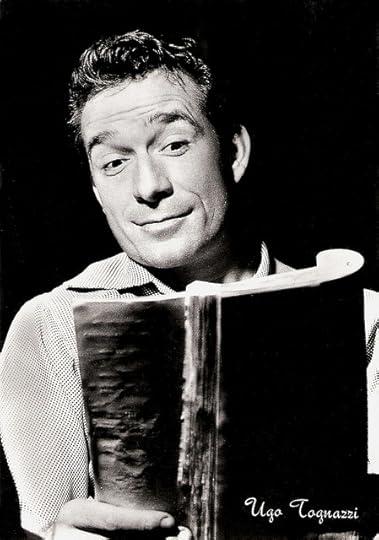
Italian postcard by Rotalfoto, Milano, no. 705.
The Ape Woman
Ugo Tognazzi had his breakthrough in the cinema with his successful role in the satire Il Federale/The Fascist (Luciano Salce, 1961). Another huge success in Italy was the political comedy I mostri/15 from Rome (Dino Risi, 1963).
In the following decade he became one of the most renowned characters of the Commedia all'Italiana (Italian comedy style). He worked with many major directors of the genre. His comedies of the 1960s include La marcia su Roma/March on Rome (Dino Risi, 1962) with Vittorio Gassman , I fuorilegge del matrimonio/Outlaws of Love (Paolo and Vittorio Taviani,Valentino Orsini, 1963), L'ape regina/The Conjugal Bed (Marco Ferreri, 1963) with Marina Vlady , and La vita agra (Carlo Lizzani, 1964).
He worked again with director Marco Ferreri at the drama La donna scimmia/The Ape Woman (1964), inspired by the real-life story of Julia Pastranam a 19th-century Mexican woman.
Hal Erickson at AllMovie : “Tognazzi stars as a charming ne'er-do-well who happens upon young Annie Girardot , who outside of the fact that she is covered with hair from head to foot is a normal woman with normal desires and dreams. Tognazzi inveigles her into the European carnival sideshow circuit as ‘The Ape Woman’, securing her cooperation by making love to her. She dies in childbirth; though overcome by grief, Tognazzi has not lost his cheapjack showman's touch, and he mummifies the bodies of both mother and daughter and continues to tour with them!”
Later Tognazzi worked again with Ferreri on Marcia nuziale/The Wedding March (Marco Ferreri, 1965) opposite Shirley Anne Field .
Tognazzi also directed some of his films, including Il fischio al naso/The Seventh Floor (1967) with Tina Louise.
Roger Vadim cast Tognazzi as Mark Hand, the Catchman, in the French-Italian Science Fiction film Barbarella (Roger Vadim, 1968). Mark Hand rescues Barbarella (Jane Fonda) from the biting dolls she encounters, and after her rescue, he requests payment by asking her to make love with him.
A great popular success in Italy was the comedy Straziami ma di baci saziami/Torture Me But Kill Me with Kisses (Dino Risi, 1968) with Nino Manfredi . The film parodies the popular Italian photo novels.
One of his most remarkable films was Porcile/Pigsty (Pier Paolo Pasolini, 1969) starring Jean-Pierre Léaud, Marco Ferreri, and Pierre Clémenti.

Italian postcard, no. 362.
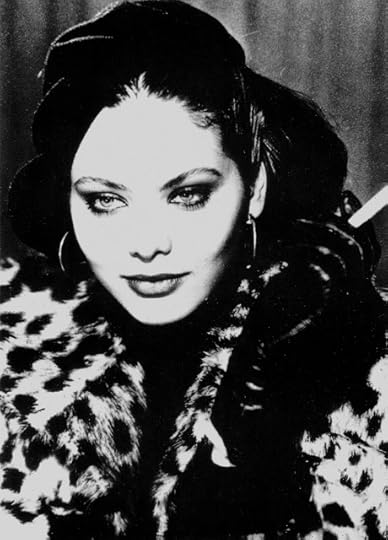 >
>
Ornella Muti . French postcard by Travelling Editions, Paris, no. CP 190.
La Grande Bouffe
During the 1970s, Ugo Tognazzi turned in another number of powerhouse character studies. He excelled as bon vivants, adulterous husbands and other suave gents in comedies as well as dramas.
He reunited with director Dino Risi and co-star Vittorio Gassman for the comedy-drama In nome del popolo italiano/In the Name of the Italian People (Dino Risi, 1971), a reflection about the crisis of the Italian judiciary and the growing phenomenon of corruption.
He also worked again with Ferreri at L'udienza/Papal Audience (Marco Ferreri, 1973) with Claudia Cardinale .
Other critical successes were the comedies Vogliamo i colonnelli/We Want the Colonels (Mario Monicelli, 1973), La proprietà non è più un furto/Property Is No Longer a Theft (Elio Petri, 1973) and the atypical commedia all'italiana film La mazurka del barone, della santa e del fico fiorone/The Mazurka of the Baron, the Saint and the Early Fig Tree (Pupi Avati, 1975).
Controversial was La grande abbuffata/La Grande Bouffe (Marco Ferreri, 1973) in which Marcello Mastroianni , Tognazzi, Michel Piccoli and Philippe Noiret gather in a villa for the weekend with the express purpose of eating themselves to death. Ferreri won the FIPRESCI Prize given by the International Federation of Film Critics at the 1973 Cannes Film Festival.
Tognazzi worked again with Ferreri on Touche pas à la femme blanche!/Don't Touch The White Woman! (Marco Ferreri, 1974), an absurd Western set in Paris featuring Catherine Deneuve .
He worked with director Mario Monicelli on the comedy dramas Romanzo popolare/Come Home and Meet My Wife (Mario Monicelli, 1973) with Ornella Muti , and Amici miei/Friends (Mario Monicelli, 1975). The latter made it to number one on the Italian box-office, in front of Steven Spielberg's Jaws (1975).
Another hit was the comedy Telefoni bianchi/The Career of a Chambermaid (Dino Risi, 1976) with Agostina Belli. Other films include the Giallo comedy Il gatto/The Cat (Luigi Comencini, 1977), the comedy drama Primo amore/First Love (Dino Risi, 1978) with Ornella Muti , and the drama L'ingorgo - Una storia impossibile/Traffic Jam (Luigi Comencini, 1979).
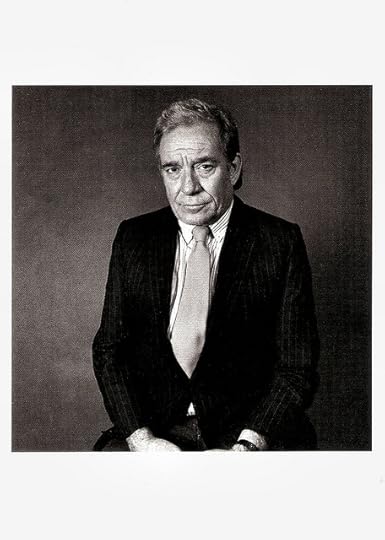
Swiss postcard by Musée de l'Elysée, no. 55607. Photo: Laurence Sudre.
La Cage aux Folles
Ugo Tognazzi had his greatest international hit with the comedy La Cage aux Folles/Birds of a Feather/Il vizietto (Édouard Molinaro, 1978), an adaptation of the 1973 play La Cage aux Folles by Jean Poiret. Tognazzi played one-half of an aging homosexual couple which operates a drag club in Saint-Tropez. Michel Serrault played Zaza, his star attraction and other half.
With its sight gags, uproarious complications, and a tender and touching conclusion, the film won over international audiences and was one of the most successful foreign films ever released in the US.
Tognazzi also appeared in the sequels La Cage aux Folles II (Édouard Molinaro, 1980), and La cage aux folles 3 - 'Elles' se marient/La Cage aux Folles 3: The Wedding (Georges Lautner, 1985).
He was also among the all-star cast of La terrazzo/The Terrace (Ettore Scola, 1980), which won two awards at the 1980 Cannes Film Festival.
In 1981, Tognazzi won the Best Male Actor Award in Cannes for La tragedia di un uomo ridicolo/ Tragedy of a Ridiculous Man (Bernardo Bertolucci, 1981) the tale of a near-bankrupt factory owner who attempts to use the kidnapping of his son (played by his real-life eldest son Ricky Tognazzi) to his financial advantage.
Other films include the comedy Scherzo del destino in agguato dietro l'angolo come un brigante da strada/A Joke of Destiny (Lina Wertmüller, 1983), Le Bon Roi Dagobert/Good King Dagobert (Dino Risi, 1984) with Coluche, and Ultimo minute/The Last Minute (Pupi Avati, 1989).
Ugo Tognazzi died of a brain hemorrhage in Rome in 1990, although rumours persist to this day that his chronic depression led to suicide.
Since 1972, he was married to actress Franca Betttoia . His sons Ricky Tognazzi (1955) and Gianmarco Tognazzi (1967) are both cinema actors.
He was also the father of the Norwegian film director and film producer Thomas Robsahm (1964), relationship with actress Margrete Robsahm. His daughter Maria Sole Tognazzi (1971) is, like Ricky, a film director.
Trailer Porcile (1969). Source: Friday13th1 (YouTube).
Trailer La Cage aux Folles (1978). Source: OldHollywoodTrailers (YouTube).
Sources: Hal Erickson (AllMovie), (IMDb), Wikipedia and .

Romanian postcard by Casa Filmului Acin.
Successful TV Comedy Duo
Ugo Tognazzi was born Ottavio Tognazzi in 1922 in Cremona, in northern Italy. He spent his youth in various localities as his father was a traveller clerk for an insurance company. After his return to his native city in 1936, he worked as a bookkeeper in a salami production plant, and performed in local amateur theatricals.
During World War II, he was inducted into the Army and returned home after the Armistice of September 1943. During the conflict he organized shows for his fellow soldiers. According to IMDb , he joined the army of the Italian Social Republic of Salò. After the end of the war, he spent a few months in prison for collaborating with the fascist regime.
In 1945, he moved to Milan, where he was enrolled in the theatrical company led by Wanda Osiris. A few years later, he formed his own successful musical revue company.
At age 28, Tognazzi made his cinematic debut in the comedy I cadetti di Guascogna/The Cadets of Gascony (Mario Mattoli, 1950) starring Walter Chiari. Other early films were the comedies Auguri e figli maschi!/ Best wishes and sons! (Giorgio Simonelli, 1951) with Delia Scala, Una Bruna indiavolata/A devilish brunette (Carlo Ludovico Bragaglia, 1951), and La Paura fa 90/Fear makes 90 (Giorgio Simonelli, 1951) starring Silvana Pampanini .
In 1951, he met Raimondo Vianello, with whom he formed a successful comedy duo for the new-born RAI TV (1954–1960). Their shows, sometimes containing satirical material, were among the first to be censored on Italian television.
At the end of the 1950s, Tognazzi returned to the cinema in Neopolitan comedies like Totò nella luna/Toto in the Moon (Steno, 1958) with Totò and Sylva Koscina , and La cambiale/The bill (Camillo Mastrocinque, 1959) with Totò and Peppino de Filippo.

Italian postcard by Rotalfoto, Milano, no. 705.
The Ape Woman
Ugo Tognazzi had his breakthrough in the cinema with his successful role in the satire Il Federale/The Fascist (Luciano Salce, 1961). Another huge success in Italy was the political comedy I mostri/15 from Rome (Dino Risi, 1963).
In the following decade he became one of the most renowned characters of the Commedia all'Italiana (Italian comedy style). He worked with many major directors of the genre. His comedies of the 1960s include La marcia su Roma/March on Rome (Dino Risi, 1962) with Vittorio Gassman , I fuorilegge del matrimonio/Outlaws of Love (Paolo and Vittorio Taviani,Valentino Orsini, 1963), L'ape regina/The Conjugal Bed (Marco Ferreri, 1963) with Marina Vlady , and La vita agra (Carlo Lizzani, 1964).
He worked again with director Marco Ferreri at the drama La donna scimmia/The Ape Woman (1964), inspired by the real-life story of Julia Pastranam a 19th-century Mexican woman.
Hal Erickson at AllMovie : “Tognazzi stars as a charming ne'er-do-well who happens upon young Annie Girardot , who outside of the fact that she is covered with hair from head to foot is a normal woman with normal desires and dreams. Tognazzi inveigles her into the European carnival sideshow circuit as ‘The Ape Woman’, securing her cooperation by making love to her. She dies in childbirth; though overcome by grief, Tognazzi has not lost his cheapjack showman's touch, and he mummifies the bodies of both mother and daughter and continues to tour with them!”
Later Tognazzi worked again with Ferreri on Marcia nuziale/The Wedding March (Marco Ferreri, 1965) opposite Shirley Anne Field .
Tognazzi also directed some of his films, including Il fischio al naso/The Seventh Floor (1967) with Tina Louise.
Roger Vadim cast Tognazzi as Mark Hand, the Catchman, in the French-Italian Science Fiction film Barbarella (Roger Vadim, 1968). Mark Hand rescues Barbarella (Jane Fonda) from the biting dolls she encounters, and after her rescue, he requests payment by asking her to make love with him.
A great popular success in Italy was the comedy Straziami ma di baci saziami/Torture Me But Kill Me with Kisses (Dino Risi, 1968) with Nino Manfredi . The film parodies the popular Italian photo novels.
One of his most remarkable films was Porcile/Pigsty (Pier Paolo Pasolini, 1969) starring Jean-Pierre Léaud, Marco Ferreri, and Pierre Clémenti.

Italian postcard, no. 362.
 >
>Ornella Muti . French postcard by Travelling Editions, Paris, no. CP 190.
La Grande Bouffe
During the 1970s, Ugo Tognazzi turned in another number of powerhouse character studies. He excelled as bon vivants, adulterous husbands and other suave gents in comedies as well as dramas.
He reunited with director Dino Risi and co-star Vittorio Gassman for the comedy-drama In nome del popolo italiano/In the Name of the Italian People (Dino Risi, 1971), a reflection about the crisis of the Italian judiciary and the growing phenomenon of corruption.
He also worked again with Ferreri at L'udienza/Papal Audience (Marco Ferreri, 1973) with Claudia Cardinale .
Other critical successes were the comedies Vogliamo i colonnelli/We Want the Colonels (Mario Monicelli, 1973), La proprietà non è più un furto/Property Is No Longer a Theft (Elio Petri, 1973) and the atypical commedia all'italiana film La mazurka del barone, della santa e del fico fiorone/The Mazurka of the Baron, the Saint and the Early Fig Tree (Pupi Avati, 1975).
Controversial was La grande abbuffata/La Grande Bouffe (Marco Ferreri, 1973) in which Marcello Mastroianni , Tognazzi, Michel Piccoli and Philippe Noiret gather in a villa for the weekend with the express purpose of eating themselves to death. Ferreri won the FIPRESCI Prize given by the International Federation of Film Critics at the 1973 Cannes Film Festival.
Tognazzi worked again with Ferreri on Touche pas à la femme blanche!/Don't Touch The White Woman! (Marco Ferreri, 1974), an absurd Western set in Paris featuring Catherine Deneuve .
He worked with director Mario Monicelli on the comedy dramas Romanzo popolare/Come Home and Meet My Wife (Mario Monicelli, 1973) with Ornella Muti , and Amici miei/Friends (Mario Monicelli, 1975). The latter made it to number one on the Italian box-office, in front of Steven Spielberg's Jaws (1975).
Another hit was the comedy Telefoni bianchi/The Career of a Chambermaid (Dino Risi, 1976) with Agostina Belli. Other films include the Giallo comedy Il gatto/The Cat (Luigi Comencini, 1977), the comedy drama Primo amore/First Love (Dino Risi, 1978) with Ornella Muti , and the drama L'ingorgo - Una storia impossibile/Traffic Jam (Luigi Comencini, 1979).

Swiss postcard by Musée de l'Elysée, no. 55607. Photo: Laurence Sudre.
La Cage aux Folles
Ugo Tognazzi had his greatest international hit with the comedy La Cage aux Folles/Birds of a Feather/Il vizietto (Édouard Molinaro, 1978), an adaptation of the 1973 play La Cage aux Folles by Jean Poiret. Tognazzi played one-half of an aging homosexual couple which operates a drag club in Saint-Tropez. Michel Serrault played Zaza, his star attraction and other half.
With its sight gags, uproarious complications, and a tender and touching conclusion, the film won over international audiences and was one of the most successful foreign films ever released in the US.
Tognazzi also appeared in the sequels La Cage aux Folles II (Édouard Molinaro, 1980), and La cage aux folles 3 - 'Elles' se marient/La Cage aux Folles 3: The Wedding (Georges Lautner, 1985).
He was also among the all-star cast of La terrazzo/The Terrace (Ettore Scola, 1980), which won two awards at the 1980 Cannes Film Festival.
In 1981, Tognazzi won the Best Male Actor Award in Cannes for La tragedia di un uomo ridicolo/ Tragedy of a Ridiculous Man (Bernardo Bertolucci, 1981) the tale of a near-bankrupt factory owner who attempts to use the kidnapping of his son (played by his real-life eldest son Ricky Tognazzi) to his financial advantage.
Other films include the comedy Scherzo del destino in agguato dietro l'angolo come un brigante da strada/A Joke of Destiny (Lina Wertmüller, 1983), Le Bon Roi Dagobert/Good King Dagobert (Dino Risi, 1984) with Coluche, and Ultimo minute/The Last Minute (Pupi Avati, 1989).
Ugo Tognazzi died of a brain hemorrhage in Rome in 1990, although rumours persist to this day that his chronic depression led to suicide.
Since 1972, he was married to actress Franca Betttoia . His sons Ricky Tognazzi (1955) and Gianmarco Tognazzi (1967) are both cinema actors.
He was also the father of the Norwegian film director and film producer Thomas Robsahm (1964), relationship with actress Margrete Robsahm. His daughter Maria Sole Tognazzi (1971) is, like Ricky, a film director.
Trailer Porcile (1969). Source: Friday13th1 (YouTube).
Trailer La Cage aux Folles (1978). Source: OldHollywoodTrailers (YouTube).
Sources: Hal Erickson (AllMovie), (IMDb), Wikipedia and .
Published on October 23, 2013 23:00
October 22, 2013
Synnöve Solbakken (1919)
Palle Brunius (1909-1976) and Solveig Hedengran (1910-1956) play in the Swedish silent melodrama Synnøve Solbakken (1919) the same characters as the stars of the film, Karin Molander and Lars Hanson, but then in their childhood.
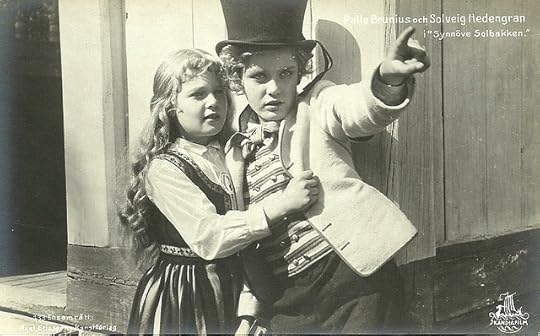
Swedish postcard by Axel Eliassons Kontsforlag, Stockholm. Photo: Skandia Film. Still with Palle Brunius and Solveig Hedengran in Synnøve Solbakken (1919).
Love Vows
Synnøve Solbakken (John W. Brunius, 1919) was based on the popular peasant story by Norwegian writer Bjørnstjerne Bjørnson, who in 1903 became the Nobel laureate in Literature. Synnøve Solbakken was his debut novel, first published in 1857.
Synnøve (Solveig Hedengran) lives with her parents at the farm Solbakken on a sunny hill. Thorbjörn (Palle Brunius), who lives at Granliden in the shadow of a big mountain, often looks wistfully up to Solbakken.
As teenagers they meet and fall in love. Another boy, Knud Nordhaug (Gösta Cederlund), is also yearning for Synnøve. Together with some companions he bullies Thorbjörn, who knocks them down. When Knud meets Synnøve's father, he gets him to believe that it is Thorbjörn who is the bully. Synnøve's parents forbid her to meet Thorbjörn henceforth.
Some years later Knud proposes to Synnøve, but is turned down. At Midsummer Eve, Thorbjörn ( Lars Hanson ) and Synnøve ( Karin Molander ) meet secretly. They renew their love-vows, and Thorbjörn promises to develop a better reputation in the village...
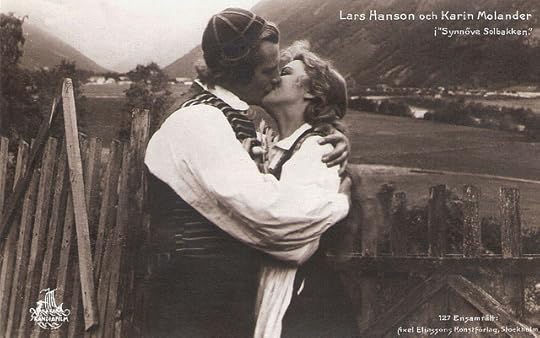
Swedish postcard by Axel Eliassons Konstförlag, Stockholm, no. 127. Photo: Skandiafilm. Still for Synnöva Solbakken (1919) with Karin Molander and Lars Hanson . Sent by mail in Norway in 1920.
A Handful of Child Roles
Paul Gomer 'Palle' Brunius (1909-1976) was the son of the director John W. Brunius and actress-director Pauline Brunius. He would only pay a handful of child roles in films by his parents.
Solveig Hedengran (1910-1956) instead acted in some 28 films, mostly Swedish sound films and often supporting parts. Synnøve Solbakken (1919) was her first film.
The film, shot in Gudbrandsdal in Norway, was a huge success in theatres throughout Scandinavia and became a thematic guide for Norwegian film production in the 1920s.
Synnøve Solbakken would be remade twice. In 1934, Tancred Ibsen directed an early sound version with Karin Ekelund as Synnøve and legendary director Victor Sjöström in a supporting part.
The third version of Synnøve Solbakken was released in 1954 by Gunnar Hellström with Synnøve Strigen in the title role.
Scene from Synnøve Solbakken (1919). Source: Norsk Filminstitutt.
Sources: Filmarkivet.no (Norwegian), Wikipedia and IMDb.

Swedish postcard by Axel Eliassons Kontsforlag, Stockholm. Photo: Skandia Film. Still with Palle Brunius and Solveig Hedengran in Synnøve Solbakken (1919).
Love Vows
Synnøve Solbakken (John W. Brunius, 1919) was based on the popular peasant story by Norwegian writer Bjørnstjerne Bjørnson, who in 1903 became the Nobel laureate in Literature. Synnøve Solbakken was his debut novel, first published in 1857.
Synnøve (Solveig Hedengran) lives with her parents at the farm Solbakken on a sunny hill. Thorbjörn (Palle Brunius), who lives at Granliden in the shadow of a big mountain, often looks wistfully up to Solbakken.
As teenagers they meet and fall in love. Another boy, Knud Nordhaug (Gösta Cederlund), is also yearning for Synnøve. Together with some companions he bullies Thorbjörn, who knocks them down. When Knud meets Synnøve's father, he gets him to believe that it is Thorbjörn who is the bully. Synnøve's parents forbid her to meet Thorbjörn henceforth.
Some years later Knud proposes to Synnøve, but is turned down. At Midsummer Eve, Thorbjörn ( Lars Hanson ) and Synnøve ( Karin Molander ) meet secretly. They renew their love-vows, and Thorbjörn promises to develop a better reputation in the village...

Swedish postcard by Axel Eliassons Konstförlag, Stockholm, no. 127. Photo: Skandiafilm. Still for Synnöva Solbakken (1919) with Karin Molander and Lars Hanson . Sent by mail in Norway in 1920.
A Handful of Child Roles
Paul Gomer 'Palle' Brunius (1909-1976) was the son of the director John W. Brunius and actress-director Pauline Brunius. He would only pay a handful of child roles in films by his parents.
Solveig Hedengran (1910-1956) instead acted in some 28 films, mostly Swedish sound films and often supporting parts. Synnøve Solbakken (1919) was her first film.
The film, shot in Gudbrandsdal in Norway, was a huge success in theatres throughout Scandinavia and became a thematic guide for Norwegian film production in the 1920s.
Synnøve Solbakken would be remade twice. In 1934, Tancred Ibsen directed an early sound version with Karin Ekelund as Synnøve and legendary director Victor Sjöström in a supporting part.
The third version of Synnøve Solbakken was released in 1954 by Gunnar Hellström with Synnøve Strigen in the title role.
Scene from Synnøve Solbakken (1919). Source: Norsk Filminstitutt.
Sources: Filmarkivet.no (Norwegian), Wikipedia and IMDb.
Published on October 22, 2013 23:00
October 21, 2013
Happy birthday, Catherine Deneuve!
Today it's the 70th birthday of elegant Catherine Deneuve (1943). She is an icon of the French cinema who graces the screen for already more than five decades. She gained recognition in the 1960s for her portrayal of cool, mysterious beauties in classic films of directors like Luis Buñuel, Roman Polanski and François Truffaut. Apart from a great actress, she is also an archetype for Gallic beauty. From 1985 to 1989, she succeeded Brigitte Bardot as the model for the national symbol Marianne, seen on French coins and stamps. Joyeux anniversaire, Mme. Deneuve.
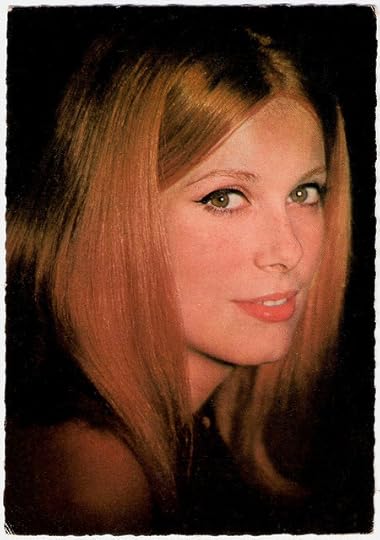
French postcard by E.D.U.G., no. 378. Photo: Sam Lévin.
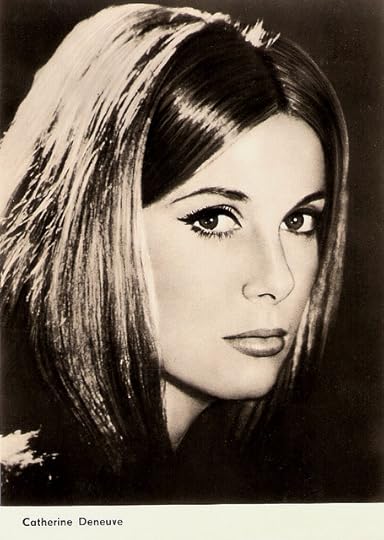
East-German postcard by VEB Progress Film-Vertrieb, Berlin, no. 2522, 1965. Retail price: 0,20 MDN. Photo: Sam Lévin.
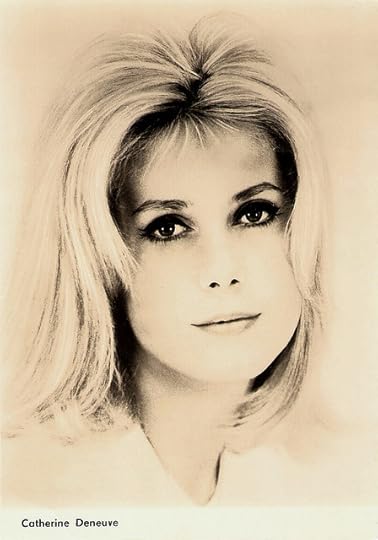
East-German postcard by VEB Progress Film-Vertrieb, Berlin, no. 2533, 1966. Retail price: 0,20 MDN.
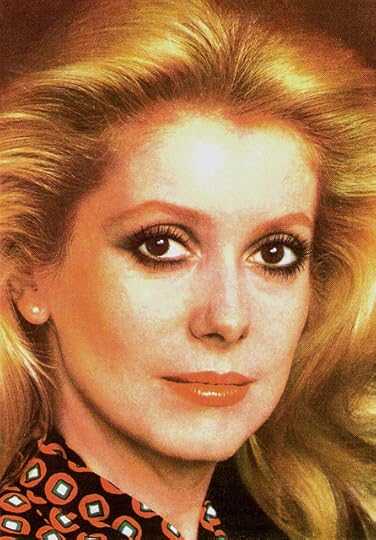
Romanian postcard by Casa Filmului Acin.
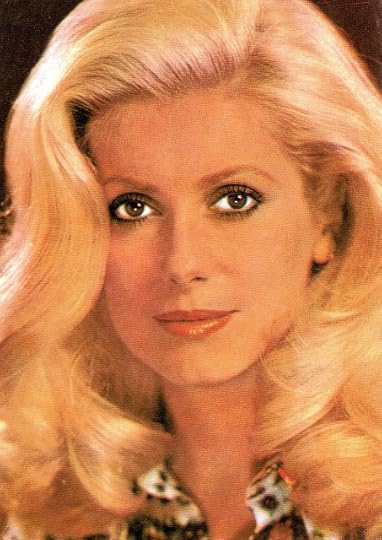
Romanian postcard by Casa Filmului Acin, no. 568.
Published on October 21, 2013 23:00
October 20, 2013
Ossi Oswalda
Ossi Oswalda (1895-1947) was one of the most popular comediennes of the German silent cinema. Ernst Lubitsch became her Pygmalion, who let her play in numerous comedies between 1916 and 1920. Her popularity at the time earned her the nickname 'The German Mary Pickford'.

French postcard in the Europe series, no. 590. Photo: Agence Européenne Cinematographique.
Ernst Lubitsch
Ossi Oswalda (1895-1947) was born in Niederschönhausen, Imperial Germany (now part of Berlin), but she was of Prague origin. Her real name was Oswalda Stäglich.
Oswalda trained as a ballerina and became a dancer for a theater in Berlin.
She made her film debut in Nächte des Grauens/Night of Horrors (Richard Oswald, Arthur Robison, 1916) before being discovered by the actor and screenwriter Hanns Kräly.
He recommended her to director Ernst Lubitsch who cast her in their comedy Schuhpalast Pinkus/Shoe Salon Pinkus (1916).
Lubitsch became her Pygmalion, who let her play in numerous comedies between 1916 and 1920, which joked with the provincial and stiff petty-bourgeois mentality of Wilhelminian Germany.
Examples are Ossis Tagebuch/Ossi's Diary (1917), Ich möchte kein Mann sein/I Don't Want to Be a Man (1918), Meine Frau, die Filmschauspielerin/My Wife the Movie Star (1919), and Die Puppe/The Doll (1919).
The best of these was Die Austernprinzessin/The Oyster Princess (1919), in which Ossi is a spoiled daughter of a wealthy American, who is supposed to wed an impoverished German prince (but is marrying his stupid servant instead).
The whole film exaggerated all the clichés about Americans who like everything big and make modern, absurdistic music, and about Germans who are only interested in food & drinks, but Lubitsch did so in a very witty way.

German postcard by Photochemie, Berlin, no. K. 1377. Photo: Alex Binder.

German postcard by Photochemie, Berlin, no. K. 3310. Photo: Karl Schenker, Berlin.

German postcard by Photochemie, Berlin, no. K. 286. Photo: Alard Walten, Berlin.

With Ernst Lubitsch. German postcard by Ross Verlag, Berlin, no. 337/1, 1919-1924. Photo: Zander & Labisch.

German postcard by Photochemie, Berlin, no. K. 1929.

German postcard by Ross Verlag, Berlin, no. 474/3, 1919-1924. Photo: Becker & Maass, Berlin.
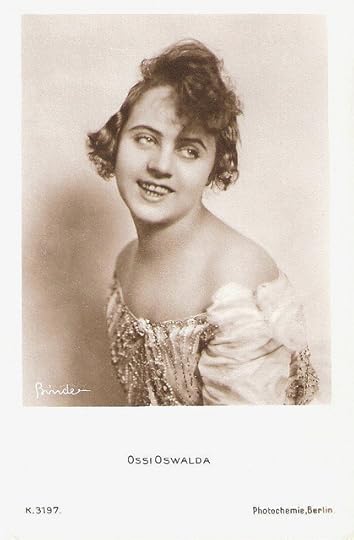
German postcard by Photochemie, Berlin, no. K. 3197. Photo: Alex Binder.
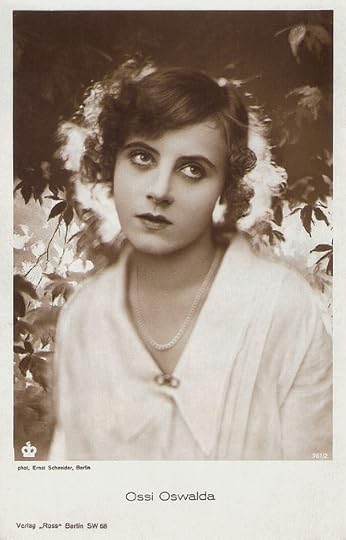
German postcard by Ross Verlag, Berlin, no. 761/2, 1925-1926. Photo: Ernst Schneider, Berlin.
Unrestrained, Wild and Witty Girl
When Ernst Lubitsch left for America he left Ossi Oswalda in the hands of Victor Janson, who had been her co-star in Die Wohnungsnot/The Housing Shortage (Ernst Lubitsch, 1920) and Kakadu und Kiebitz/Kakadu and Kiebitz (Erich Schönfelder, 1920).
Janson was not unworthy for his task but he repeated Oswalda's typology of the unrestrained, wild and witty girl, without adding the spice Lubitsch always had added.
In 1921, Oswalda started her own film production company with her husband at the time, baron Gustav von Koczian.
However, during the next four years they only produced four films, including Amor am Steuer/Love at the Wheel (Victor Janson, 1921) and Das Mädel mit der Maske/The Girl With the Mask (Victor Janson), 1922 with Hermann Thimig .
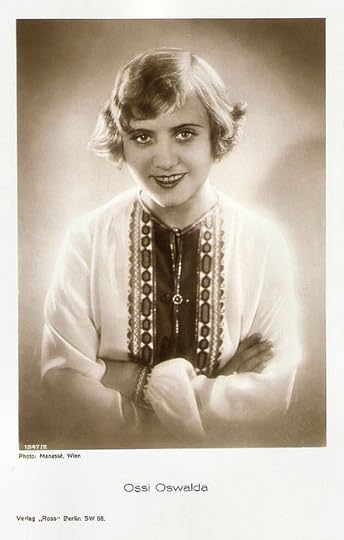
German postcard by Ross Verlag, no. 1347/2, 1927-1928. Photo: Manassé, Wien.
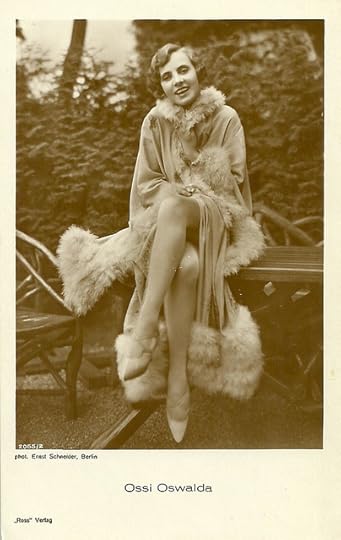
German postcard by Ross Verlag, no. 2055/2, 1927-1928. Photo: Ernst Schneider, Berlin.
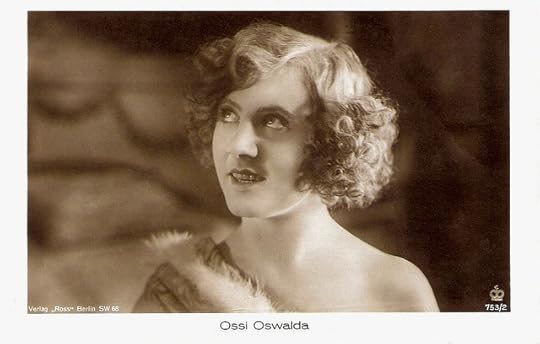
German postcard by Ross Verlag, Berlin, no. 753/2, 1925-1926.
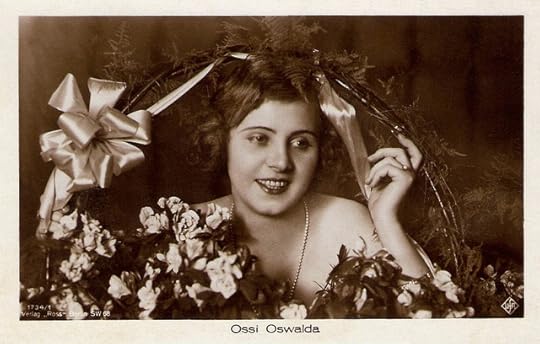
German postcard by Ross Verlag, no. 1734/1, 1927-1928. Photo: Ufa.
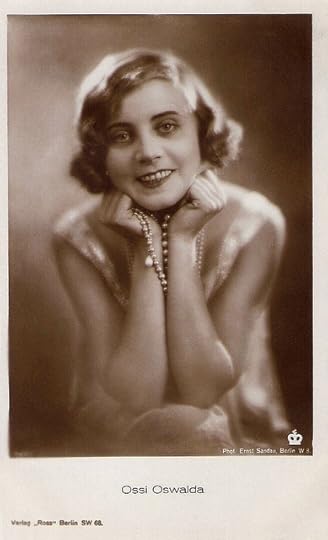
German postcard by Ross Verlag, Berlin. Photo: Ernst Sandau, Berlin.

German postcard by Ross Verlag, no. 761/5,1925-1926. Photo: Ernst Schneider, Berlin.
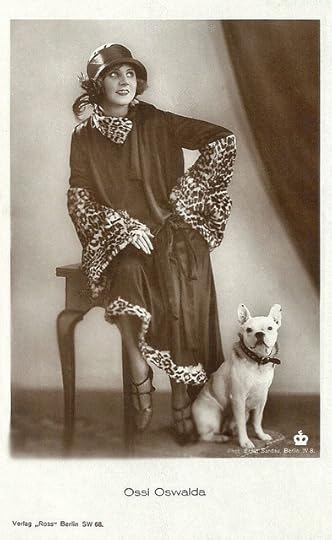
German postcard by Ross Verlag, Berlin. Photo: Ernst Sandau, Berlin.

German postcard by Ross Verlag, Berlin, no. 1050/1, 1927-1928. Photo: Ufa.
Crown Prince
From 1925 on, Ossi Oswalda was contracted to the Ufa. She starred in comedies like Blitzzug der Liebe/Love Express Train (Johannes Guter, 1925) and Herrn Filip Collins Abenteuer/Mr. Filip Collins Adventure (Johannes Guter, 1926) with Georg Alexander .
When Oswalda's name was romantically linked to that of former Crown Prince Wilhelm, while that of Lily Damita with the prince's son Ludwig Ferdinand, insulting caricatures spread and the Hohenzollern family stopped both affairs short.
The affair also influenced Oswalda's career, who continued to make films but she would never reached the top anymore. Her star dwindled down, and her parts became smaller and smaller.
She appeared in only two sound films, making her final film appearance in Der Stern von Valencia/The Star of Valencia (Alfred Zeisler, 1933).
Later on, she became a stage actor, and in 1943, she wrote the story for the Czechoslovakian film Ctrnáctý u stolu (Oldrich Nový, Antonín Zelenka, 1943).
For a short while, Ossi Oswalda was the talk of the town again once more, after she had died in the most miserable condition in Prague in 1947.
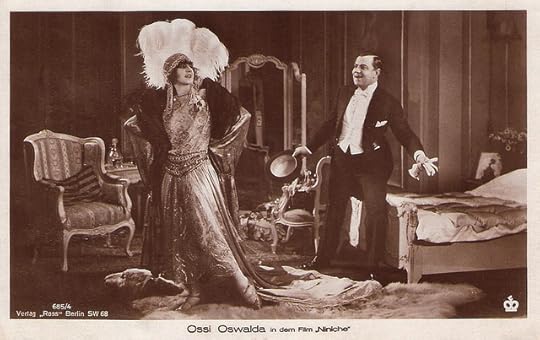
German postcard by Ross Verlag, Berlin, no. 685/4, 1919-1924. Photo: publicity still for Niniche (Victor Janson, 1925).

German postcard by Ross Verlag, no. 474/1, 1919-1924. Photo: Becker & Maass, Berlin.
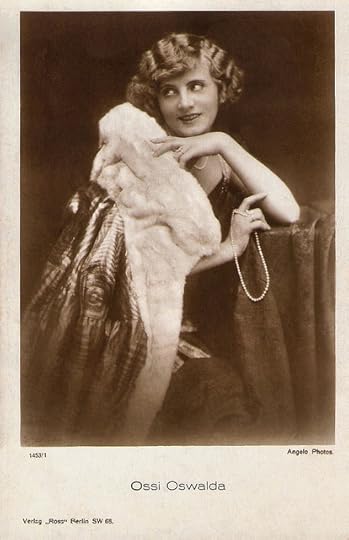
German postcard by Ross Verlag, Berlin, no. 1453/1, 1927-1928. Photo: Angelo Photos.

German postcard by Ross Verlag, Berlin, no. 1050/3, 1927-1928. Photo: Ufa.
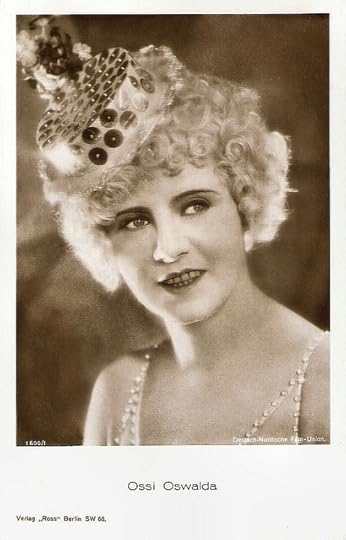
German postcard by Ross Verlag, no. 1690/1, 1927-1928. Photo: Deutsch-Nordische Film-Union.
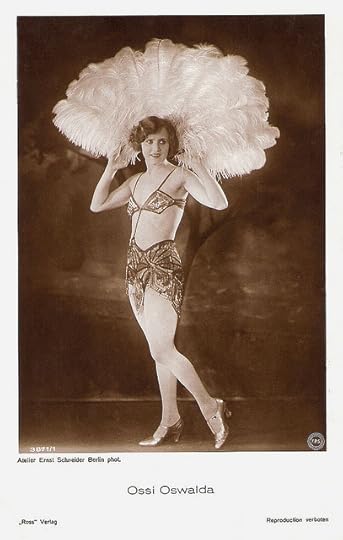
German postcard by Ross Verlag, Berlin, no. 3871/1, 1928-1929. Photo: Atelier Ernst Schneider, Berlin / FPS.

German postcard by Ross Verlag, Berlin, no. 1480/1, 1927-1928. Photo: Ufa.
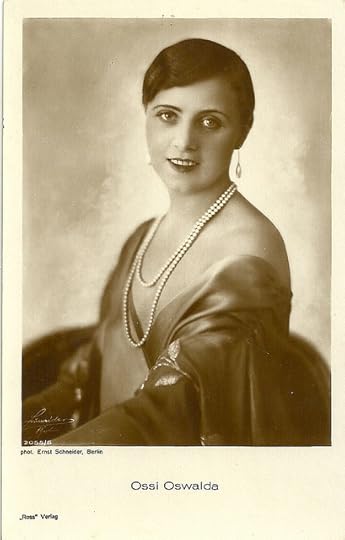
German postcard by Ross Verlag, no. 2055/5, 1927-1928. Photo: Ernst Schneider, Berlin.

German postcard by Ross Verlag, no. 4244/1, 1929-1930. Photo Atelier Manassé, Vienna.
Scene from Die Austernprinzessin/The Oyster Princess (1919). Source: Jfahr (youTube).
Source: Vittorio Martinelli (Le dive del silenzio) (Italian), Wikipedia, and .

French postcard in the Europe series, no. 590. Photo: Agence Européenne Cinematographique.
Ernst Lubitsch
Ossi Oswalda (1895-1947) was born in Niederschönhausen, Imperial Germany (now part of Berlin), but she was of Prague origin. Her real name was Oswalda Stäglich.
Oswalda trained as a ballerina and became a dancer for a theater in Berlin.
She made her film debut in Nächte des Grauens/Night of Horrors (Richard Oswald, Arthur Robison, 1916) before being discovered by the actor and screenwriter Hanns Kräly.
He recommended her to director Ernst Lubitsch who cast her in their comedy Schuhpalast Pinkus/Shoe Salon Pinkus (1916).
Lubitsch became her Pygmalion, who let her play in numerous comedies between 1916 and 1920, which joked with the provincial and stiff petty-bourgeois mentality of Wilhelminian Germany.
Examples are Ossis Tagebuch/Ossi's Diary (1917), Ich möchte kein Mann sein/I Don't Want to Be a Man (1918), Meine Frau, die Filmschauspielerin/My Wife the Movie Star (1919), and Die Puppe/The Doll (1919).
The best of these was Die Austernprinzessin/The Oyster Princess (1919), in which Ossi is a spoiled daughter of a wealthy American, who is supposed to wed an impoverished German prince (but is marrying his stupid servant instead).
The whole film exaggerated all the clichés about Americans who like everything big and make modern, absurdistic music, and about Germans who are only interested in food & drinks, but Lubitsch did so in a very witty way.

German postcard by Photochemie, Berlin, no. K. 1377. Photo: Alex Binder.

German postcard by Photochemie, Berlin, no. K. 3310. Photo: Karl Schenker, Berlin.

German postcard by Photochemie, Berlin, no. K. 286. Photo: Alard Walten, Berlin.

With Ernst Lubitsch. German postcard by Ross Verlag, Berlin, no. 337/1, 1919-1924. Photo: Zander & Labisch.

German postcard by Photochemie, Berlin, no. K. 1929.

German postcard by Ross Verlag, Berlin, no. 474/3, 1919-1924. Photo: Becker & Maass, Berlin.

German postcard by Photochemie, Berlin, no. K. 3197. Photo: Alex Binder.

German postcard by Ross Verlag, Berlin, no. 761/2, 1925-1926. Photo: Ernst Schneider, Berlin.
Unrestrained, Wild and Witty Girl
When Ernst Lubitsch left for America he left Ossi Oswalda in the hands of Victor Janson, who had been her co-star in Die Wohnungsnot/The Housing Shortage (Ernst Lubitsch, 1920) and Kakadu und Kiebitz/Kakadu and Kiebitz (Erich Schönfelder, 1920).
Janson was not unworthy for his task but he repeated Oswalda's typology of the unrestrained, wild and witty girl, without adding the spice Lubitsch always had added.
In 1921, Oswalda started her own film production company with her husband at the time, baron Gustav von Koczian.
However, during the next four years they only produced four films, including Amor am Steuer/Love at the Wheel (Victor Janson, 1921) and Das Mädel mit der Maske/The Girl With the Mask (Victor Janson), 1922 with Hermann Thimig .

German postcard by Ross Verlag, no. 1347/2, 1927-1928. Photo: Manassé, Wien.

German postcard by Ross Verlag, no. 2055/2, 1927-1928. Photo: Ernst Schneider, Berlin.

German postcard by Ross Verlag, Berlin, no. 753/2, 1925-1926.

German postcard by Ross Verlag, no. 1734/1, 1927-1928. Photo: Ufa.

German postcard by Ross Verlag, Berlin. Photo: Ernst Sandau, Berlin.

German postcard by Ross Verlag, no. 761/5,1925-1926. Photo: Ernst Schneider, Berlin.

German postcard by Ross Verlag, Berlin. Photo: Ernst Sandau, Berlin.

German postcard by Ross Verlag, Berlin, no. 1050/1, 1927-1928. Photo: Ufa.
Crown Prince
From 1925 on, Ossi Oswalda was contracted to the Ufa. She starred in comedies like Blitzzug der Liebe/Love Express Train (Johannes Guter, 1925) and Herrn Filip Collins Abenteuer/Mr. Filip Collins Adventure (Johannes Guter, 1926) with Georg Alexander .
When Oswalda's name was romantically linked to that of former Crown Prince Wilhelm, while that of Lily Damita with the prince's son Ludwig Ferdinand, insulting caricatures spread and the Hohenzollern family stopped both affairs short.
The affair also influenced Oswalda's career, who continued to make films but she would never reached the top anymore. Her star dwindled down, and her parts became smaller and smaller.
She appeared in only two sound films, making her final film appearance in Der Stern von Valencia/The Star of Valencia (Alfred Zeisler, 1933).
Later on, she became a stage actor, and in 1943, she wrote the story for the Czechoslovakian film Ctrnáctý u stolu (Oldrich Nový, Antonín Zelenka, 1943).
For a short while, Ossi Oswalda was the talk of the town again once more, after she had died in the most miserable condition in Prague in 1947.

German postcard by Ross Verlag, Berlin, no. 685/4, 1919-1924. Photo: publicity still for Niniche (Victor Janson, 1925).

German postcard by Ross Verlag, no. 474/1, 1919-1924. Photo: Becker & Maass, Berlin.

German postcard by Ross Verlag, Berlin, no. 1453/1, 1927-1928. Photo: Angelo Photos.

German postcard by Ross Verlag, Berlin, no. 1050/3, 1927-1928. Photo: Ufa.

German postcard by Ross Verlag, no. 1690/1, 1927-1928. Photo: Deutsch-Nordische Film-Union.

German postcard by Ross Verlag, Berlin, no. 3871/1, 1928-1929. Photo: Atelier Ernst Schneider, Berlin / FPS.

German postcard by Ross Verlag, Berlin, no. 1480/1, 1927-1928. Photo: Ufa.

German postcard by Ross Verlag, no. 2055/5, 1927-1928. Photo: Ernst Schneider, Berlin.

German postcard by Ross Verlag, no. 4244/1, 1929-1930. Photo Atelier Manassé, Vienna.
Scene from Die Austernprinzessin/The Oyster Princess (1919). Source: Jfahr (youTube).
Source: Vittorio Martinelli (Le dive del silenzio) (Italian), Wikipedia, and .
Published on October 20, 2013 23:00
October 19, 2013
Maria-Rosa Rodriguez
Exotic starlet Maria-Rosa Rodriguez was the sexy leading lady of a dozen French and Italian films of the 1960s and early 1970s. Her main claim to fame was the Louis de Funès comedy Le grand restaurant (1966).

German postcard by Krüger, no. 902/335. Photo: Art Messick.
Miss Ecuador Mundo 1960
There is not much biographical information to be found about Maria-Rosa Rodriguez on the internet. A source suggests that she was a Spanish actress, but possibly she is born in Ecuador: in 1960 a Maria-Rosa Rodriguez was crowned Miss Ecuador Mundo 1960.
However, there is a bit more information about her film career. IMDb writes that during her film career she was also credited as Maria Rosa Rodrigues, Rosa-Maria Rodrigues, Rosa Rodriguez and Toty Rodriguez.
Her first film appearance was an uncredited part as ‘Palma Diamantino’ in the French comedy Pouic-Pouic (Jean Girault, 1963) starring Louis de Funès . Soon followed more film parts as a stripper in the kinky cannibal comedy Aimez-vous les femmes?/Do You Like Women? (Jean Léon, 1964), co-written by Roman Polanski, and the sexploitation drama L'amour à la chaine/Tight Skirts, Loose Pleasures (Claude de Givray, 1964).
Maria Rosa appeared again as eye-candy in the spy film Coplan FX 18/FX-18 Superspy (Riccardo Freda, 1964), the comedy Les gorilles/The Gorillas (Jean Girault, 1964) and the crime comedy La grande frousse/The Big Scare (Jean-Pierre Mocky, 1964) starring Bourvil .
Other French films of the mid-1960s with her were Les enquiquineurs/The pests (Roland Quignon, 1965), the comedy anthology Les bons vivants/How to Keep the Red Lamp Burning (Gilles Grangier, Georges Lautner, 1965) and the melodrama Le chant du monde/Song of the World (Marcel Camus, 1965) starring Hardy Krüger .

German postcard by Krüger, no. 902/334. Photo: Art Messick.
Comedy Hit
1966 must have been quite a good year for Maria-Rosa Rodriguez. She was the leading lady opposite the immensely popular Louis de Funès in the hit comedy Le grand restaurant/The Big Restaurant (Jacques Besnard, 1966).
The choleric and energetic De Funès is the chef of Septim's, a very exclusive Paris restaurant. Problems occur when the president of an unnamed country gets kidnapped while having a dinner at Septim's. With police, gangsters and Maria-Rosa Rodriquez behind his back the always gesticularing De Funès tries to find the missing head of state by himself. The highlight of the film is a fabulous scene where a DS Citroen falls into a river and continues its ride as a boat.
Rodriguez soon followed this success up with a role in the fun filled caper Estouffade à la Caraïbe/The Gold Robbers (Jacques Besnard, 1967) costarring with swimming champion Frederick Stafford, Jean Seberg and Serge Gainsbourg. She also appeared on TV in Amalia Escudero, an episode of Au théâtre ce soir/Tonight at the Theatre (1966). More TV roles followed in series like Les chevaliers du ciel/The Aeronauts (1967) – about the adventures of the French comic book heroes Tanguy and Laverdure - and Fortune (Henri Colpi, 1969).
In the early 1970s she moved to Italy where she appeared in the Giallo Il coltello di ghiaccio/Knife of Ice (Umberto Lenzi, 1972) starring Carroll Baker . Her last film according to IMDb was a Spanish horror production, La novia ensangrentada/Blood Castle (Vincente Aranda, 1972).
Most of Maria-Rosa Rodriguez’s filmographies on the net stop here, but she kept on working as an actress. Under the name of Toty Rodriguez she is now a well known stage actress in Ecuador.
In 1989 she appeared in another film, the East-German production Die Besteigung des Chimborazo/The Ascent of the Chimborazo (Rainer Simon, 1989) filmed on location in Germany, France, Spain and Ecuador. In this adventure film she appeared briefly as a countess.
More recently she was seen in a leading part in the Ecuadorian film Un titán en el ring/A Titan in the Ring (Viviana Cordero, 2002). According to Rotten Tomatoes it’s a shocking drama set in a small village in the mountainous region of the Andes, where the children are drawn to a new priest and the prime entertainment is a series of masked wrestling matches held at a local coliseum.
French trailer for Le grand restaurant (1966). Source: Imineo (YouTube).
Creepy scene from Il coltello di ghiaccio/Knife of Ice (1972) with Carroll Baker and Elaine Stewart. Source: Stranevisioni (YouTube).
Clip from a Spanish language TV Telerama programme about the career of Toty Rodriguez. (Sorry, the sound is terrible.) Source: Videosetv1 (YouTube).
Sources: , AllMovie, Rotten Tomatoes and Wikipedia.

German postcard by Krüger, no. 902/335. Photo: Art Messick.
Miss Ecuador Mundo 1960
There is not much biographical information to be found about Maria-Rosa Rodriguez on the internet. A source suggests that she was a Spanish actress, but possibly she is born in Ecuador: in 1960 a Maria-Rosa Rodriguez was crowned Miss Ecuador Mundo 1960.
However, there is a bit more information about her film career. IMDb writes that during her film career she was also credited as Maria Rosa Rodrigues, Rosa-Maria Rodrigues, Rosa Rodriguez and Toty Rodriguez.
Her first film appearance was an uncredited part as ‘Palma Diamantino’ in the French comedy Pouic-Pouic (Jean Girault, 1963) starring Louis de Funès . Soon followed more film parts as a stripper in the kinky cannibal comedy Aimez-vous les femmes?/Do You Like Women? (Jean Léon, 1964), co-written by Roman Polanski, and the sexploitation drama L'amour à la chaine/Tight Skirts, Loose Pleasures (Claude de Givray, 1964).
Maria Rosa appeared again as eye-candy in the spy film Coplan FX 18/FX-18 Superspy (Riccardo Freda, 1964), the comedy Les gorilles/The Gorillas (Jean Girault, 1964) and the crime comedy La grande frousse/The Big Scare (Jean-Pierre Mocky, 1964) starring Bourvil .
Other French films of the mid-1960s with her were Les enquiquineurs/The pests (Roland Quignon, 1965), the comedy anthology Les bons vivants/How to Keep the Red Lamp Burning (Gilles Grangier, Georges Lautner, 1965) and the melodrama Le chant du monde/Song of the World (Marcel Camus, 1965) starring Hardy Krüger .

German postcard by Krüger, no. 902/334. Photo: Art Messick.
Comedy Hit
1966 must have been quite a good year for Maria-Rosa Rodriguez. She was the leading lady opposite the immensely popular Louis de Funès in the hit comedy Le grand restaurant/The Big Restaurant (Jacques Besnard, 1966).
The choleric and energetic De Funès is the chef of Septim's, a very exclusive Paris restaurant. Problems occur when the president of an unnamed country gets kidnapped while having a dinner at Septim's. With police, gangsters and Maria-Rosa Rodriquez behind his back the always gesticularing De Funès tries to find the missing head of state by himself. The highlight of the film is a fabulous scene where a DS Citroen falls into a river and continues its ride as a boat.
Rodriguez soon followed this success up with a role in the fun filled caper Estouffade à la Caraïbe/The Gold Robbers (Jacques Besnard, 1967) costarring with swimming champion Frederick Stafford, Jean Seberg and Serge Gainsbourg. She also appeared on TV in Amalia Escudero, an episode of Au théâtre ce soir/Tonight at the Theatre (1966). More TV roles followed in series like Les chevaliers du ciel/The Aeronauts (1967) – about the adventures of the French comic book heroes Tanguy and Laverdure - and Fortune (Henri Colpi, 1969).
In the early 1970s she moved to Italy where she appeared in the Giallo Il coltello di ghiaccio/Knife of Ice (Umberto Lenzi, 1972) starring Carroll Baker . Her last film according to IMDb was a Spanish horror production, La novia ensangrentada/Blood Castle (Vincente Aranda, 1972).
Most of Maria-Rosa Rodriguez’s filmographies on the net stop here, but she kept on working as an actress. Under the name of Toty Rodriguez she is now a well known stage actress in Ecuador.
In 1989 she appeared in another film, the East-German production Die Besteigung des Chimborazo/The Ascent of the Chimborazo (Rainer Simon, 1989) filmed on location in Germany, France, Spain and Ecuador. In this adventure film she appeared briefly as a countess.
More recently she was seen in a leading part in the Ecuadorian film Un titán en el ring/A Titan in the Ring (Viviana Cordero, 2002). According to Rotten Tomatoes it’s a shocking drama set in a small village in the mountainous region of the Andes, where the children are drawn to a new priest and the prime entertainment is a series of masked wrestling matches held at a local coliseum.
French trailer for Le grand restaurant (1966). Source: Imineo (YouTube).
Creepy scene from Il coltello di ghiaccio/Knife of Ice (1972) with Carroll Baker and Elaine Stewart. Source: Stranevisioni (YouTube).
Clip from a Spanish language TV Telerama programme about the career of Toty Rodriguez. (Sorry, the sound is terrible.) Source: Videosetv1 (YouTube).
Sources: , AllMovie, Rotten Tomatoes and Wikipedia.
Published on October 19, 2013 23:00
October 18, 2013
Imported from the USA: George Nader
Ruggedly handsome American actor George Nader (1921-2002) was a Universal star of second features in the 1950s. Was the muscular beefcake star then sacrificed to the tabloids in order to save Rock Hudson's heterosexual reputation? During the 1960s, Nader’s career had a second life in the European cinema as secret agent Jerry Cotton.

German postcard by Franz Josef Rüdel, Filmpostkartenverlag, Hamburg, no. 4250. Photo: Constantin / Studio Hamburg / Allianz / Astoria / Winterstein. Publicity still for Schüsse aus dem Geigenkasten/Operation Hurricane: Friday Noon (Fritz Umgelter, 1965) with George Nader as Jerry Cotton.
Tall And Muscular
George Nader was born in Pasadena, California, USA in 1921 (1932 according to some sources). He was the second son of Alice (née Scott) and George G. Nader, vice-president of a grocery chain.
During World War II he served in the US Navy as a communications officer in the Pacific Theatre of Operations. After the war, he earned his bachelor of arts in theatre arts at Occidental College and appeared in productions at the Pasadena Playhouse.
In 1947, he met Mark Miller, who had one of the lead roles in a Pasadena Playhouse production of Oh, Susannah! Nader was in the chorus. The two fell in love and established a household together. Miller had intended to go to New York to study opera but abandoned his plans in order to stay in California and help Nader launch his career.
Nader got small parts in the Western Rustlers on Horseback (Fred C. Brannon, 1950) and other B-movies. He got the lead role as Roy, the hero who saves the world from the clutches of ‘Ro-man’ in the low-budget 3D thriller Robot Monster (Phil Tucker, 1953). The film shot in only four days for a mere sixteen thousand dollars, took in over a million dollars in its first run. In the 1980s the Medved brothers listed it among the ‘50 worst films of all time’ and it became a cult classic.
The tall and muscular Nader had also a sonorous voice and was offered a contract by Universal Pictures. He usually played parts that emphasized his ‘beefcake’ and he frequently appeared in swimsuits with his chest hair intact.
In the mid-1950s, he played in several popular films, like the Western Four Guns to the Border (Richard Carlson, 1954) with Rory Calhoun, the crime drama Six Bridges to Cross (Joseph Pevney, 1955) opposite Tony Curtis, and the WWII actioner Away All Boats (Joseph Pevney, 1956), co-starring with Jeff Chandler. In 1954, he even won a Golden Globe Award for Most Promising Newcomer.
Unfortunately, the studio already had such good-looking and athletic stars as Rock Hudson and Tony Curtis on its roster. Nader often found himself being cast in such second features as the Film Noirs Appointment with a Shadow (Richard Carlson, 1957) and The Female Animal (Harry Keller, 1958), with Hedy Lamarr in her final appearance.

German postcard by WS-Druck, Wanne-Eickel, no. 440. Photo: Universal / Filmpress, Zürich.
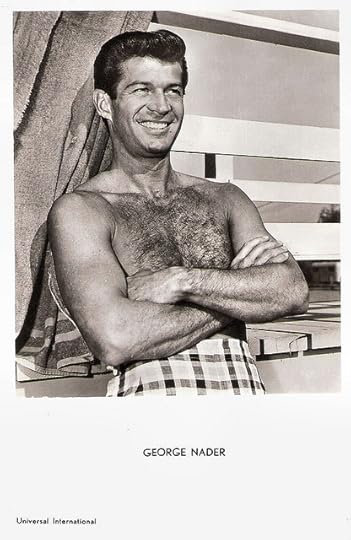
Vintage postcard, no. 30. Photo: Universal International.

British postcard in the Celebrity Autograph Series by Celebrity Publishers Ltd., London, no. 224. Photo: Universal. Publicity still for Lady Godiva of Coventry (Arthur Lubin, 1955).
G-man Jerry Cotton
At the end of the 1950s, George Nader tried his hand at TV series, including the NBC adventure offering The Man and the Challenge (1959–1960) and Shannon (1961-1962), and then relocated to Europe.
In Italy he played musketeer D’Artagnan in Il colpo segreto di d'Artagnan/The Secret Mark of D'Artagnan (Siro Marcellini, 1962) with Magali Noël . In Portugal he appeared in the Eurospy film Misión Lisboa/Mission Lisbon (Federico Aicardi, Tulio Demicheli, 1965).
But he found his biggest success in West Germany as G-man Jerry Cotton in the crime thriller Schüsse aus dem Geigenkasten/Operation Hurricane: Friday Noon (Fritz Umgelter, 1965). FBI-agent Cotton was Germany's answer to James Bond.
Murph-15 at IMDb : “In comparison to the Bond films, the Jerry Cotton movies are not as 'posh', but they are better stories. Operation Hurricane is the first and best of the series. The story is very interesting, with a few turns to keep the viewer going up to the end.”
In the following years, Nader enjoyed a modest career revival as Jerry Cotton in a series of such Eurospy films and he became the number two most popular film star in Germany behind Lex Barker .
His eight Cotton films include Die Rechnung - eiskalt serviert/Tip Not Included (Helmut Ashley, 1966), Der Tod im roten Jaguar/Death in the Red Jaguar (Harald Reinl, 1968) and finally Todesschüsse am Broadway/Broadway's Deadly Gold (Harald Reinl, 1969), with Heinz Weiss.
He returned to the US, where he played in TV series and in a final film, the fantasy Beyond Atlantis (Eddie Romero, 1973) starring Patrick Wayne. Nader retired completely from acting in 1974 because an eye injury made him particularly sensitive to the bright lights of movie sets.
According to an interview with the German fanzine Splatting Image his eye injury was the result of an accident during the production of the never released movie Zigzag (Albert Zugsmith, 1963), when a blank pistol round exploded too early next to his eyes. Filming took place in the Philippines, and no adequate treatment was taken in time, resulting in the partial loss of his eyesight.

German promotion card for for Um Null Uhr schnappt die Falle zu/3-2-1 Countdown for Manhattan (Harald Philipp, 1966) with George Nader as Jerry Cotton.
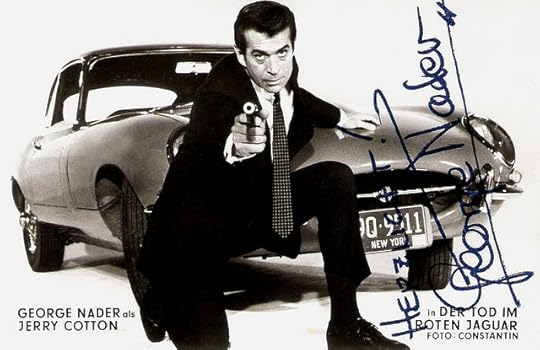
German postcard by Franz Josef Rüdel, Filmpostkartenverlag, Hamburg. Photo: Constantin. Publicity still for Der Tod im Roten Jaguar/Death in the Red Jaguar (Harald Reinl, 1968) with George Nader as Jerry Cotton.
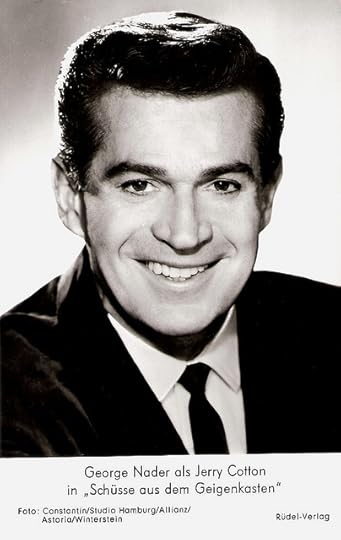
German postcard by Franz Josef Rüdel, Filmpostkartenverlag, Hamburg, no. 4249. Photo: Constantin / Studio Hamburg / Allianz / Astoria / Winterstein. Publicity still for Schüsse aus dem Geigenkasten/Operation Hurricane: Friday Noon (Fritz Umgelter, 1965) with George Nader as Jerry Cotton.
Forbidden Love
George Nader turned to writing and dabbled in real estate. His Sci-Fi novel Chrome (1978) told the story of forbidden love between a human and a robot, a metaphor about the place of gay men in society.
Nader and Mark Miller collaborated on a second novel, The Perils of Paul. It is about gays in Hollywood with names camouflaged and was published privately in hardcover in 1999.
In 1985, Nader was named one of the beneficiaries of Rock Hudson's $27M estate when the star died of AIDS.
Nader came out of the closet in 1986. Timothy Sexton at Yahoo! and IMDb both suggest that “Nader's career was sacrificed to (tabloid) Confidential in order to save Rock's much more lucrative heterosexual reputation".
In the mid-1950s, rumours about Nader's homosexuality had begun to surface. Nader and Miller were living together, but neither publicly acknowledged his homosexuality. Universal arranged for Nader to be seen on dates with beautiful stars as Martha Hyer and Piper Laurie.
Linda Rapp at glbtq : “One publicist even went so far as to suggest that to avoid being outed by Confidential . Nader should marry and then get a divorce a few years later. A female secretary was willing to participate in the scheme. Nader and Miller discussed the possibility, but Nader could not bring himself to take part in such a sham.”
Nader, many years later in an interview: “We lived in fear of an exposé, or even one small remark, a veiled suggestion that someone was homosexual. Such a remark would have caused an earthquake at the studio. Every month, when Confidential came out, our stomachs began to turn. Which of us would be it?”
However, such a tabloid article about Nader is not known ( Confidential did publish an outing story about Tab Hunter). Nader and Hudson were life-long friends and Mark Miller was even Hudson's personal secretary for nearly 13 years.
In 2002, George Nader died at the Motion Picture and Television Hospital in Woodland Hills, Los Angeles of a cardiac pulmonary failure, pneumonia and multiple cerebral infarctions. He was 80 and was survived by Mark Miller, with whom he had spent 55 years, and by two cousins and his nephew, actor Michael Nader.
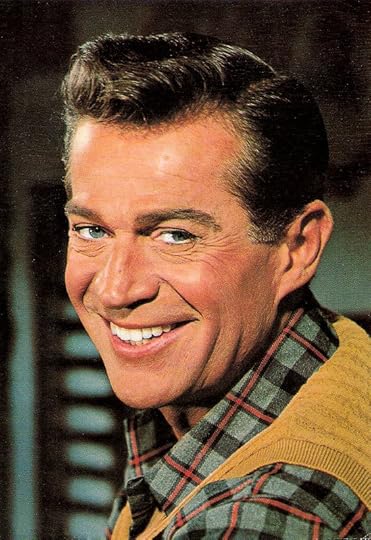
German postcard by ISV, no. E 38. Photo: Constantin. Publicity still for Die Rechnung - eiskalt serviert/Tip Not Included (Helmut Ashley, 1966) with George Nader as Jerry Cotton.
This was the ninth episode of 'Imported from the USA'. Earlier episodes were dedicated to Jayne Mansfield, Josephine Baker, Lex Barker, Anna May Wong, Carroll Baker, Farley Granger, Louise Brooks and Orson Welles.
Sources: Linda Rapp (glbtq), Army Archerd (Variety), Timothy Sexton (Yahoo!), Strange Words, The New York Times, Wikipedia, and .

German postcard by Franz Josef Rüdel, Filmpostkartenverlag, Hamburg, no. 4250. Photo: Constantin / Studio Hamburg / Allianz / Astoria / Winterstein. Publicity still for Schüsse aus dem Geigenkasten/Operation Hurricane: Friday Noon (Fritz Umgelter, 1965) with George Nader as Jerry Cotton.
Tall And Muscular
George Nader was born in Pasadena, California, USA in 1921 (1932 according to some sources). He was the second son of Alice (née Scott) and George G. Nader, vice-president of a grocery chain.
During World War II he served in the US Navy as a communications officer in the Pacific Theatre of Operations. After the war, he earned his bachelor of arts in theatre arts at Occidental College and appeared in productions at the Pasadena Playhouse.
In 1947, he met Mark Miller, who had one of the lead roles in a Pasadena Playhouse production of Oh, Susannah! Nader was in the chorus. The two fell in love and established a household together. Miller had intended to go to New York to study opera but abandoned his plans in order to stay in California and help Nader launch his career.
Nader got small parts in the Western Rustlers on Horseback (Fred C. Brannon, 1950) and other B-movies. He got the lead role as Roy, the hero who saves the world from the clutches of ‘Ro-man’ in the low-budget 3D thriller Robot Monster (Phil Tucker, 1953). The film shot in only four days for a mere sixteen thousand dollars, took in over a million dollars in its first run. In the 1980s the Medved brothers listed it among the ‘50 worst films of all time’ and it became a cult classic.
The tall and muscular Nader had also a sonorous voice and was offered a contract by Universal Pictures. He usually played parts that emphasized his ‘beefcake’ and he frequently appeared in swimsuits with his chest hair intact.
In the mid-1950s, he played in several popular films, like the Western Four Guns to the Border (Richard Carlson, 1954) with Rory Calhoun, the crime drama Six Bridges to Cross (Joseph Pevney, 1955) opposite Tony Curtis, and the WWII actioner Away All Boats (Joseph Pevney, 1956), co-starring with Jeff Chandler. In 1954, he even won a Golden Globe Award for Most Promising Newcomer.
Unfortunately, the studio already had such good-looking and athletic stars as Rock Hudson and Tony Curtis on its roster. Nader often found himself being cast in such second features as the Film Noirs Appointment with a Shadow (Richard Carlson, 1957) and The Female Animal (Harry Keller, 1958), with Hedy Lamarr in her final appearance.

German postcard by WS-Druck, Wanne-Eickel, no. 440. Photo: Universal / Filmpress, Zürich.

Vintage postcard, no. 30. Photo: Universal International.

British postcard in the Celebrity Autograph Series by Celebrity Publishers Ltd., London, no. 224. Photo: Universal. Publicity still for Lady Godiva of Coventry (Arthur Lubin, 1955).
G-man Jerry Cotton
At the end of the 1950s, George Nader tried his hand at TV series, including the NBC adventure offering The Man and the Challenge (1959–1960) and Shannon (1961-1962), and then relocated to Europe.
In Italy he played musketeer D’Artagnan in Il colpo segreto di d'Artagnan/The Secret Mark of D'Artagnan (Siro Marcellini, 1962) with Magali Noël . In Portugal he appeared in the Eurospy film Misión Lisboa/Mission Lisbon (Federico Aicardi, Tulio Demicheli, 1965).
But he found his biggest success in West Germany as G-man Jerry Cotton in the crime thriller Schüsse aus dem Geigenkasten/Operation Hurricane: Friday Noon (Fritz Umgelter, 1965). FBI-agent Cotton was Germany's answer to James Bond.
Murph-15 at IMDb : “In comparison to the Bond films, the Jerry Cotton movies are not as 'posh', but they are better stories. Operation Hurricane is the first and best of the series. The story is very interesting, with a few turns to keep the viewer going up to the end.”
In the following years, Nader enjoyed a modest career revival as Jerry Cotton in a series of such Eurospy films and he became the number two most popular film star in Germany behind Lex Barker .
His eight Cotton films include Die Rechnung - eiskalt serviert/Tip Not Included (Helmut Ashley, 1966), Der Tod im roten Jaguar/Death in the Red Jaguar (Harald Reinl, 1968) and finally Todesschüsse am Broadway/Broadway's Deadly Gold (Harald Reinl, 1969), with Heinz Weiss.
He returned to the US, where he played in TV series and in a final film, the fantasy Beyond Atlantis (Eddie Romero, 1973) starring Patrick Wayne. Nader retired completely from acting in 1974 because an eye injury made him particularly sensitive to the bright lights of movie sets.
According to an interview with the German fanzine Splatting Image his eye injury was the result of an accident during the production of the never released movie Zigzag (Albert Zugsmith, 1963), when a blank pistol round exploded too early next to his eyes. Filming took place in the Philippines, and no adequate treatment was taken in time, resulting in the partial loss of his eyesight.

German promotion card for for Um Null Uhr schnappt die Falle zu/3-2-1 Countdown for Manhattan (Harald Philipp, 1966) with George Nader as Jerry Cotton.

German postcard by Franz Josef Rüdel, Filmpostkartenverlag, Hamburg. Photo: Constantin. Publicity still for Der Tod im Roten Jaguar/Death in the Red Jaguar (Harald Reinl, 1968) with George Nader as Jerry Cotton.

German postcard by Franz Josef Rüdel, Filmpostkartenverlag, Hamburg, no. 4249. Photo: Constantin / Studio Hamburg / Allianz / Astoria / Winterstein. Publicity still for Schüsse aus dem Geigenkasten/Operation Hurricane: Friday Noon (Fritz Umgelter, 1965) with George Nader as Jerry Cotton.
Forbidden Love
George Nader turned to writing and dabbled in real estate. His Sci-Fi novel Chrome (1978) told the story of forbidden love between a human and a robot, a metaphor about the place of gay men in society.
Nader and Mark Miller collaborated on a second novel, The Perils of Paul. It is about gays in Hollywood with names camouflaged and was published privately in hardcover in 1999.
In 1985, Nader was named one of the beneficiaries of Rock Hudson's $27M estate when the star died of AIDS.
Nader came out of the closet in 1986. Timothy Sexton at Yahoo! and IMDb both suggest that “Nader's career was sacrificed to (tabloid) Confidential in order to save Rock's much more lucrative heterosexual reputation".
In the mid-1950s, rumours about Nader's homosexuality had begun to surface. Nader and Miller were living together, but neither publicly acknowledged his homosexuality. Universal arranged for Nader to be seen on dates with beautiful stars as Martha Hyer and Piper Laurie.
Linda Rapp at glbtq : “One publicist even went so far as to suggest that to avoid being outed by Confidential . Nader should marry and then get a divorce a few years later. A female secretary was willing to participate in the scheme. Nader and Miller discussed the possibility, but Nader could not bring himself to take part in such a sham.”
Nader, many years later in an interview: “We lived in fear of an exposé, or even one small remark, a veiled suggestion that someone was homosexual. Such a remark would have caused an earthquake at the studio. Every month, when Confidential came out, our stomachs began to turn. Which of us would be it?”
However, such a tabloid article about Nader is not known ( Confidential did publish an outing story about Tab Hunter). Nader and Hudson were life-long friends and Mark Miller was even Hudson's personal secretary for nearly 13 years.
In 2002, George Nader died at the Motion Picture and Television Hospital in Woodland Hills, Los Angeles of a cardiac pulmonary failure, pneumonia and multiple cerebral infarctions. He was 80 and was survived by Mark Miller, with whom he had spent 55 years, and by two cousins and his nephew, actor Michael Nader.

German postcard by ISV, no. E 38. Photo: Constantin. Publicity still for Die Rechnung - eiskalt serviert/Tip Not Included (Helmut Ashley, 1966) with George Nader as Jerry Cotton.
This was the ninth episode of 'Imported from the USA'. Earlier episodes were dedicated to Jayne Mansfield, Josephine Baker, Lex Barker, Anna May Wong, Carroll Baker, Farley Granger, Louise Brooks and Orson Welles.
Sources: Linda Rapp (glbtq), Army Archerd (Variety), Timothy Sexton (Yahoo!), Strange Words, The New York Times, Wikipedia, and .
Published on October 18, 2013 23:00
October 17, 2013
Anna Neagle
Endearing Anna Neagle (1904-1986) was a leading star in British films for over 25 years from 1932 till the late 1950s. She provided glamour and sophistication to war-torn London audiences with her lightweight musicals, comedies and historical dramas. Almost all of her films were produced and directed by Herbert Wilcox, whom she married in 1943.
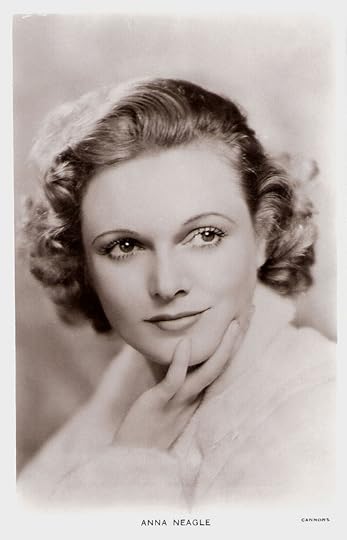
British postcard by Real Photograph in the Picturegoer Series, no. 867a. Photo: Cannons.
Overnight Favourite
Anna Neagle was born Florence Marjorie Robertson in Forest Gate (near London), in 1904. She was the daughter of Herbert Robertson, a merchant navy captain, and his wife, the former Florence Neagle. Her brother was actor Stuart Robinson.
She made her stage debut as a dancer in 1917. In 1925 she appeared in the chorus of André Charlot's revue Bubbly, and later also in C.B. Cochran's revues, where she understudied Jessie Matthews .
Actor Jack Buchanan encouraged her to take on a featured role in the musical Stand Up and Sing (1931), and she began using the professional name of Anna Neagle (the surname being her mother's maiden name). The play was a huge success with a total run of 604 performances.
Her big break came when film producer-director Herbert Wilcox caught the show purposely to consider Buchanan for his upcoming film. He was taken (and smitten) with Anna.
Photographing extremely well, Neagle was a natural for the screen and she played her first starring film role opposite Jack Buchanan in the musical Goodnight Vienna (Herbert Wilcox, 1932).
Neagle became an overnight favourite. Although the film cost a mere £23,000, it was a huge hit at the box office, profits from its Australian release alone being £150,000.
After her starring role in The Flag Lieutenant (Henry Edwards, 1932), she worked exclusively under Wilcox's direction for all but one of her subsequent films, becoming one of Britain's biggest stars.
She continued in the musical genre, co-starring with Fernand Gravey (aka Fernand Gravet) in Bitter Sweet (1933), the first film version of Noel Coward's tale of ill-fated lovers.

British postcard by Real Photograph, London in the Picturegoer series, no. 867. Photo: Cannons.
Critical Accolades
Anna Neagle had her first major film success in the title role of Nell Gwynn (1934), as the woman who became the mistress of Charles II (Sir Cedric Hardwicke).
In the United States, the Hays Office had Wilcox add a (historically false) scene featuring the two leads getting married and also a ´framing story´ resulting in an entirely different ending.
Author Graham Greene said of Nell Gwynn: "I have seen few things more attractive than Miss Neagle in breeches".
Two years later, she followed up with another real-life figure, Irish actress Peg Woffington in Peg of Old Drury (1936).
Neagle and Wilcox then made the backstage musical Limelight (1936) and a circus trapeze fable The Three Maxims (1937).
The latter film, with a script co-written by Herman J. Mankiewicz (who later co-wrote Citizen Kane), had Neagle performing her own high-wire acrobatics.
Although now highly successful in films, Neagle continued to act on stage too. In 1934, she performed as Rosalind in As You Like It and Olivia in Twelfth Night, directed by Robert Atkins. She earned critical accolades in both productions, despite the fact that she had never before done any Shakespeare.

British postcard by Real Photograph, London in the Picturegoer series, no. 672.
Queen Victoria
In 1937 Anna Neagle gave her most prestigious performance so far – as Queen Victoria in the successful historical drama Victoria the Great (1937), co-starring Anton Walbrook as Prince Albert.
Victoria the Great was such an international success that it resulted in Neagle and Walbrook essaying their roles again in an all-Technicolor sequel entitled Sixty Glorious Years (1938), co-starring C. Aubrey Smith as the Duke of Wellington.
While the first of these films was in release, Neagle returned to the London stage in the title role in Peter Pan.
The two Queen Victoria biographies were successful enough to get Wilcox and Neagle a contract with RKO Radio Pictures, and they moved to Hollywood at the end of the 1930´s.
Their first American film was Nurse Edith Cavell (1939). She essayed the role of the true-life nurse who was shot by the Germans in World War I for alleged spying. The film had a significant impact for audiences on the eve of war.
In a turnabout from this serious drama, they followed with three musical comedies, all based on once-popular stage plays. The first was Irene (1940), co-starring Ray Milland . It included a Technicolor sequence, which featured Neagle singing the play's most famous song, Alice Blue Gown.

British postcard by Real Photograph, no. 101. Photo: British & Dominions Films.
Entertaining the Troops
Anna Neagle followed this film with No, No, Nanette (1940) with Victor Mature, and Sunny (1941) with Ray Bolger.
During the war Anna entertained the troops. Her final American film was Forever and a Day (1943), a tale of a London family house from 1804 to the 1940 blitz.
This film boasts 80 performers (mostly British), including Ray Milland , C. Aubrey Smith, Claude Rains , Charles Laughton , and – among the few Americans – Buster Keaton.
Wilcox directed the sequence featuring Neagle, Milland, Smith, and Rains, while other directors who worked on the film included René Clair, Edmund Goulding, Frank Lloyd, Victor Saville and Robert Stevenson.
During the war the profits and salaries were given to war relief. After the war, prints were slated to be destroyed, so that no one could profit from them. However, this never occurred.

British postcard by Real Photograph, London, no. 148.
Undercover Agent
Returning to England, Anna Neagle and Herbert Wilcox commenced with They Flew Alone (1942). Neagle added another real-life British heroines to her gallery, this time as aviatrix Amy Johnson. The film, released a year after the aviatrix’s death, was noted for inter-cutting the action with newsreel footage.
They returned to filmmaking with the war-time espionage thriller The Yellow Canary (1943), co-starring Richard Greene and Margaret Rutherford. Neagle played a German-sympathiser (or that is what she seems to be at first) who is forced to go to Canada for her own safety. In reality, she's working as an undercover agent.
After making this film, Neagle and Wilcox made their professional relationship a personal one as well when they married in 1943.
In 1945 Neagle appeared on stage in Emma, a dramatization of Jane Austen's novel. That same year she was seen in the film I Live in Grosvenor Square, co-starring Rex Harrison .
For seven straight years after WWII, she was voted top favourite English actress.
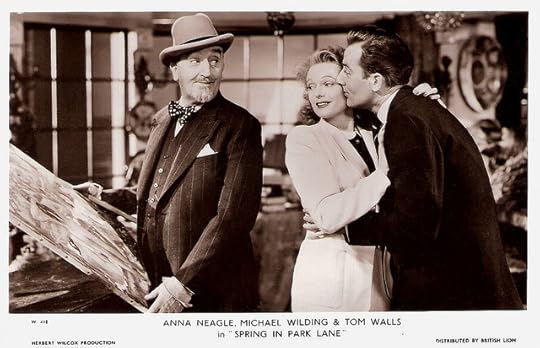
British postcard in the Picturegoer Series, London, no. W 418. Photo: Herbert Wilcox Production / British Lion. Publicity still for Spring in Park Lane (Herbert Wilcox, 1948) with Tom Walls and Michael Wilding.
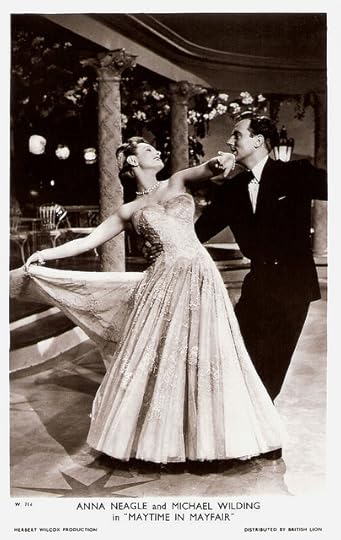
British postcard in the Picturegoer Series, London, no. W 714. Photo: Herbert Wilcox Production / British Lion. Publicity still for Maytime in Mayfair (Herbert Wilcox, 1949) with Michael Wilding.
The Greatest Team in British Films
She wanted Harrison again for the lead in her next film, Piccadilly Incident (1946). He proved to be unavailable, so Wilcox cast Michael Wilding in the lead.
Thus was born what film critic Godfrey Winn called "the greatest team in British films".
The story – of a wife, presumed dead, returning to her (remarried) husband – bears a resemblance to the Irene Dunne-Cary Grant comedy My Favorite Wife. Piccadilly Incident was chosen as Picturegoer’s Best Film of 1947.
Neagle and Wilding were reunited in The Courtneys of Curzon Street (1947), a period drama that became the year's top box-office attraction. The film featured Wilding as an upper-class dandy and Neagle as the maid he marries, only to have the two of them driven apart by Victorian society.
The third pairing of Neagle and Wilding in the London films, as the series of films came to be called, was in Spring in Park Lane (1948), which depicted the romance between a millionaire’s niece and a valet. Spring in Park Lane was the 1949 Picturegoer winner for Best Film, Actor and Actress.
Neagle and Wilding were together for a fourth time in the Technicolor romance Maytime in Mayfair (1949). The plot is reminiscent of Roberta, as it had Wilding inheriting a dress shop owned by Neagle.
David Absalom comments on his great website BritishPictures.com : “These films rarely pleased the critics. This is particularly true of the 'London Series' of frothy nonsense, usually co-starring Michael Wilding and usually musicals. The critics wanted neo-realist pictures depicting grim reality - the audience, who were suffering through the Austerity Years and knew all about grim reality, wanted fun and escapism. Anna Neagle pictures provided that in spades.”

British postcard, no. 257.

British postcard by Real Photograph, London in the Picturegoer series, no. W 700. Photo: Herbert Wilcox Prods.
Florence Nightingale
By 1950, Anna Neagle was at her zenith as Britain’s top box-office actress, and in that year she made what reputedly became her own favourite film, Odette, co-starring Trevor Howard , Peter Ustinov, and Marius Goring. As Odette Sansom, she was the Anglo-French resistance fighter who was pushed to the edge of betrayal by the Nazis.
Going from this real-life British heroine, she went straight on to playing Florence Nightingale in The Lady with the Lamp (1951).
Returning to the stage in 1953, she scored a major success with The Glorious Days, which had a run of 476 performances.
Neagle and Wilcox brought the play to the screen under the title Lilacs in the Spring (1954), co-starring Errol Flynn. In the film she plays an actress knocked out by a bomb, who dreams she is Queen Victoria and Nell Gwyn – as well as her own mother. As she begins dreaming, the film switches from black and white to colour.
Neagle and Flynn reteamed for a second film together, King's Rhapsody (1955), based on an Ivor Novello musical. Although Neagle performed several musical numbers for the film, most of them were cut from the final release, leaving her with essentially a supporting role.
Shot in Eastmancolor and CinemaScope with location work near Barcelona, Spain, King's Rhapsody was a major flop everywhere. Neagle's (and Flynn's) box-office appeal, it seemed, was beginning to fade.
Neagle's last box-office hit was My Teenage Daughter (1956), which featured her as a mother trying to prevent her daughter (Sylvia Syms) from lapsing into juvenile delinquency.

British postcard by Real Photograph, London. Photo: Herbert Wilcox Productions.
Bankrupt
Anna Neagle and Syms worked together again on No Time For Tears (Cyril Frankel, 1957), also starring Anthony Quayle and Flora Robson. As directed by Cyril Frankel, this was the first film for over 20 years where Neagle was directed by someone other than Herbert Wilcox.
She produced a series of films directed by her husband, including These Dangerous Years (1957), Wonderful Things! (1958), and The Heart of a Man (1959).
The films all starred pop idol Frankie Vaughan , but they were out of touch with changing tastes, and lost money, resulting in Wilcox going heavily into debt.
Neagle herself made her final film appearance in The Lady is a Square (1959) opposite Frankie Vaughan .
Herbert Wilcox was bankrupt by 1964, but his wife soon revived his fortunes.
She returned to the stage the following year and made a spectacular comeback in the West End musical Charlie Girl. In it she played the role of a former ´Cochran Young Lady´ who marries a peer of the realm.

British postcard by Real Photograph, no. 101A. Photo: British & Dominions Films.
Dame of the British Empire
Charlie Girl was a phenomenal success that ran for a staggering six years and 2,047 performances. During the show's six-year run, Anna Neagle was made a Dame of the British Empire in 1970 in recognition of her work.
Two years after Charlie Girl she appeared in a revival of No, No, Nanette, which she had done onscreen three decades earlier.
In 1975, she replaced Celia Johnson in The Dame of Sark and in 1978 (the year after her husband's death), she was acting in Most Gracious Lady, which was written for the Silver Jubilee of Queen Elizabeth II.
Although plagued by Parkinson's disease in her later years, Neagle continued to be active well into her eighties.
On TV she was last seen in an episode of Roald Dahl's Tales of the Unexpected (1983). In 1985 she appeared as the Fairy Godmother in a production of Cinderella at the London Palladium.
Anna Neagle was still working in 1986, just a few weeks before her death in West Byfleet, England, from complications of renal disease and cancer. She was 81.
Movie Legends - Anna Neagle. Source: Basil Nelson (YouTube).
Sources: Roger Phillip Mellor (Encyclopedia of British Cinema), David Absalom (BritishPictures.com), Bruce Eder (AllMovie), (IMDb), Wikipedia and .

British postcard by Real Photograph in the Picturegoer Series, no. 867a. Photo: Cannons.
Overnight Favourite
Anna Neagle was born Florence Marjorie Robertson in Forest Gate (near London), in 1904. She was the daughter of Herbert Robertson, a merchant navy captain, and his wife, the former Florence Neagle. Her brother was actor Stuart Robinson.
She made her stage debut as a dancer in 1917. In 1925 she appeared in the chorus of André Charlot's revue Bubbly, and later also in C.B. Cochran's revues, where she understudied Jessie Matthews .
Actor Jack Buchanan encouraged her to take on a featured role in the musical Stand Up and Sing (1931), and she began using the professional name of Anna Neagle (the surname being her mother's maiden name). The play was a huge success with a total run of 604 performances.
Her big break came when film producer-director Herbert Wilcox caught the show purposely to consider Buchanan for his upcoming film. He was taken (and smitten) with Anna.
Photographing extremely well, Neagle was a natural for the screen and she played her first starring film role opposite Jack Buchanan in the musical Goodnight Vienna (Herbert Wilcox, 1932).
Neagle became an overnight favourite. Although the film cost a mere £23,000, it was a huge hit at the box office, profits from its Australian release alone being £150,000.
After her starring role in The Flag Lieutenant (Henry Edwards, 1932), she worked exclusively under Wilcox's direction for all but one of her subsequent films, becoming one of Britain's biggest stars.
She continued in the musical genre, co-starring with Fernand Gravey (aka Fernand Gravet) in Bitter Sweet (1933), the first film version of Noel Coward's tale of ill-fated lovers.

British postcard by Real Photograph, London in the Picturegoer series, no. 867. Photo: Cannons.
Critical Accolades
Anna Neagle had her first major film success in the title role of Nell Gwynn (1934), as the woman who became the mistress of Charles II (Sir Cedric Hardwicke).
In the United States, the Hays Office had Wilcox add a (historically false) scene featuring the two leads getting married and also a ´framing story´ resulting in an entirely different ending.
Author Graham Greene said of Nell Gwynn: "I have seen few things more attractive than Miss Neagle in breeches".
Two years later, she followed up with another real-life figure, Irish actress Peg Woffington in Peg of Old Drury (1936).
Neagle and Wilcox then made the backstage musical Limelight (1936) and a circus trapeze fable The Three Maxims (1937).
The latter film, with a script co-written by Herman J. Mankiewicz (who later co-wrote Citizen Kane), had Neagle performing her own high-wire acrobatics.
Although now highly successful in films, Neagle continued to act on stage too. In 1934, she performed as Rosalind in As You Like It and Olivia in Twelfth Night, directed by Robert Atkins. She earned critical accolades in both productions, despite the fact that she had never before done any Shakespeare.

British postcard by Real Photograph, London in the Picturegoer series, no. 672.
Queen Victoria
In 1937 Anna Neagle gave her most prestigious performance so far – as Queen Victoria in the successful historical drama Victoria the Great (1937), co-starring Anton Walbrook as Prince Albert.
Victoria the Great was such an international success that it resulted in Neagle and Walbrook essaying their roles again in an all-Technicolor sequel entitled Sixty Glorious Years (1938), co-starring C. Aubrey Smith as the Duke of Wellington.
While the first of these films was in release, Neagle returned to the London stage in the title role in Peter Pan.
The two Queen Victoria biographies were successful enough to get Wilcox and Neagle a contract with RKO Radio Pictures, and they moved to Hollywood at the end of the 1930´s.
Their first American film was Nurse Edith Cavell (1939). She essayed the role of the true-life nurse who was shot by the Germans in World War I for alleged spying. The film had a significant impact for audiences on the eve of war.
In a turnabout from this serious drama, they followed with three musical comedies, all based on once-popular stage plays. The first was Irene (1940), co-starring Ray Milland . It included a Technicolor sequence, which featured Neagle singing the play's most famous song, Alice Blue Gown.

British postcard by Real Photograph, no. 101. Photo: British & Dominions Films.
Entertaining the Troops
Anna Neagle followed this film with No, No, Nanette (1940) with Victor Mature, and Sunny (1941) with Ray Bolger.
During the war Anna entertained the troops. Her final American film was Forever and a Day (1943), a tale of a London family house from 1804 to the 1940 blitz.
This film boasts 80 performers (mostly British), including Ray Milland , C. Aubrey Smith, Claude Rains , Charles Laughton , and – among the few Americans – Buster Keaton.
Wilcox directed the sequence featuring Neagle, Milland, Smith, and Rains, while other directors who worked on the film included René Clair, Edmund Goulding, Frank Lloyd, Victor Saville and Robert Stevenson.
During the war the profits and salaries were given to war relief. After the war, prints were slated to be destroyed, so that no one could profit from them. However, this never occurred.

British postcard by Real Photograph, London, no. 148.
Undercover Agent
Returning to England, Anna Neagle and Herbert Wilcox commenced with They Flew Alone (1942). Neagle added another real-life British heroines to her gallery, this time as aviatrix Amy Johnson. The film, released a year after the aviatrix’s death, was noted for inter-cutting the action with newsreel footage.
They returned to filmmaking with the war-time espionage thriller The Yellow Canary (1943), co-starring Richard Greene and Margaret Rutherford. Neagle played a German-sympathiser (or that is what she seems to be at first) who is forced to go to Canada for her own safety. In reality, she's working as an undercover agent.
After making this film, Neagle and Wilcox made their professional relationship a personal one as well when they married in 1943.
In 1945 Neagle appeared on stage in Emma, a dramatization of Jane Austen's novel. That same year she was seen in the film I Live in Grosvenor Square, co-starring Rex Harrison .
For seven straight years after WWII, she was voted top favourite English actress.

British postcard in the Picturegoer Series, London, no. W 418. Photo: Herbert Wilcox Production / British Lion. Publicity still for Spring in Park Lane (Herbert Wilcox, 1948) with Tom Walls and Michael Wilding.

British postcard in the Picturegoer Series, London, no. W 714. Photo: Herbert Wilcox Production / British Lion. Publicity still for Maytime in Mayfair (Herbert Wilcox, 1949) with Michael Wilding.
The Greatest Team in British Films
She wanted Harrison again for the lead in her next film, Piccadilly Incident (1946). He proved to be unavailable, so Wilcox cast Michael Wilding in the lead.
Thus was born what film critic Godfrey Winn called "the greatest team in British films".
The story – of a wife, presumed dead, returning to her (remarried) husband – bears a resemblance to the Irene Dunne-Cary Grant comedy My Favorite Wife. Piccadilly Incident was chosen as Picturegoer’s Best Film of 1947.
Neagle and Wilding were reunited in The Courtneys of Curzon Street (1947), a period drama that became the year's top box-office attraction. The film featured Wilding as an upper-class dandy and Neagle as the maid he marries, only to have the two of them driven apart by Victorian society.
The third pairing of Neagle and Wilding in the London films, as the series of films came to be called, was in Spring in Park Lane (1948), which depicted the romance between a millionaire’s niece and a valet. Spring in Park Lane was the 1949 Picturegoer winner for Best Film, Actor and Actress.
Neagle and Wilding were together for a fourth time in the Technicolor romance Maytime in Mayfair (1949). The plot is reminiscent of Roberta, as it had Wilding inheriting a dress shop owned by Neagle.
David Absalom comments on his great website BritishPictures.com : “These films rarely pleased the critics. This is particularly true of the 'London Series' of frothy nonsense, usually co-starring Michael Wilding and usually musicals. The critics wanted neo-realist pictures depicting grim reality - the audience, who were suffering through the Austerity Years and knew all about grim reality, wanted fun and escapism. Anna Neagle pictures provided that in spades.”

British postcard, no. 257.

British postcard by Real Photograph, London in the Picturegoer series, no. W 700. Photo: Herbert Wilcox Prods.
Florence Nightingale
By 1950, Anna Neagle was at her zenith as Britain’s top box-office actress, and in that year she made what reputedly became her own favourite film, Odette, co-starring Trevor Howard , Peter Ustinov, and Marius Goring. As Odette Sansom, she was the Anglo-French resistance fighter who was pushed to the edge of betrayal by the Nazis.
Going from this real-life British heroine, she went straight on to playing Florence Nightingale in The Lady with the Lamp (1951).
Returning to the stage in 1953, she scored a major success with The Glorious Days, which had a run of 476 performances.
Neagle and Wilcox brought the play to the screen under the title Lilacs in the Spring (1954), co-starring Errol Flynn. In the film she plays an actress knocked out by a bomb, who dreams she is Queen Victoria and Nell Gwyn – as well as her own mother. As she begins dreaming, the film switches from black and white to colour.
Neagle and Flynn reteamed for a second film together, King's Rhapsody (1955), based on an Ivor Novello musical. Although Neagle performed several musical numbers for the film, most of them were cut from the final release, leaving her with essentially a supporting role.
Shot in Eastmancolor and CinemaScope with location work near Barcelona, Spain, King's Rhapsody was a major flop everywhere. Neagle's (and Flynn's) box-office appeal, it seemed, was beginning to fade.
Neagle's last box-office hit was My Teenage Daughter (1956), which featured her as a mother trying to prevent her daughter (Sylvia Syms) from lapsing into juvenile delinquency.

British postcard by Real Photograph, London. Photo: Herbert Wilcox Productions.
Bankrupt
Anna Neagle and Syms worked together again on No Time For Tears (Cyril Frankel, 1957), also starring Anthony Quayle and Flora Robson. As directed by Cyril Frankel, this was the first film for over 20 years where Neagle was directed by someone other than Herbert Wilcox.
She produced a series of films directed by her husband, including These Dangerous Years (1957), Wonderful Things! (1958), and The Heart of a Man (1959).
The films all starred pop idol Frankie Vaughan , but they were out of touch with changing tastes, and lost money, resulting in Wilcox going heavily into debt.
Neagle herself made her final film appearance in The Lady is a Square (1959) opposite Frankie Vaughan .
Herbert Wilcox was bankrupt by 1964, but his wife soon revived his fortunes.
She returned to the stage the following year and made a spectacular comeback in the West End musical Charlie Girl. In it she played the role of a former ´Cochran Young Lady´ who marries a peer of the realm.

British postcard by Real Photograph, no. 101A. Photo: British & Dominions Films.
Dame of the British Empire
Charlie Girl was a phenomenal success that ran for a staggering six years and 2,047 performances. During the show's six-year run, Anna Neagle was made a Dame of the British Empire in 1970 in recognition of her work.
Two years after Charlie Girl she appeared in a revival of No, No, Nanette, which she had done onscreen three decades earlier.
In 1975, she replaced Celia Johnson in The Dame of Sark and in 1978 (the year after her husband's death), she was acting in Most Gracious Lady, which was written for the Silver Jubilee of Queen Elizabeth II.
Although plagued by Parkinson's disease in her later years, Neagle continued to be active well into her eighties.
On TV she was last seen in an episode of Roald Dahl's Tales of the Unexpected (1983). In 1985 she appeared as the Fairy Godmother in a production of Cinderella at the London Palladium.
Anna Neagle was still working in 1986, just a few weeks before her death in West Byfleet, England, from complications of renal disease and cancer. She was 81.
Movie Legends - Anna Neagle. Source: Basil Nelson (YouTube).
Sources: Roger Phillip Mellor (Encyclopedia of British Cinema), David Absalom (BritishPictures.com), Bruce Eder (AllMovie), (IMDb), Wikipedia and .
Published on October 17, 2013 23:00
October 16, 2013
Gaston Modot
French actor Gaston Modot (1887-1970) starred both in silent and sound films by such major directors as Abel Gance, Luis Buñuel, Jean Renoir, Marcel Carné, and Julien Duvivier.
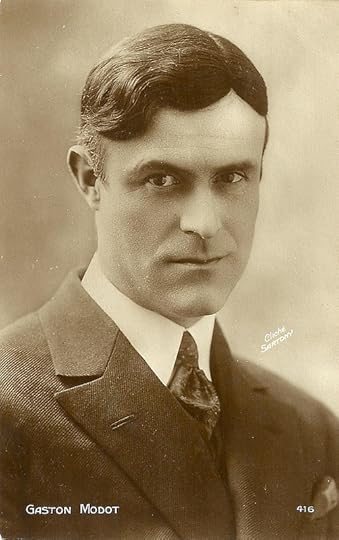
French postcard by Editions Cinémagazine, no. 416. Photo: Cliché Sartony.
Comedies Series and Westerns in the Camarque
French actor Gaston Modot was born in Paris in 1887. For over 50 years (1909-1962) he was active as a film actor, playing with almost all important French directors.
Modot, the son of an architect, originally was interested in painting. At the beginning of the 20th century he lived in Montmartre, meeting Picasso and Modigliani, but also writers like Blaise Cendrars.
After a try at painting he became a film set decorator, thus entering the world of cinema.
In 1909 he started to act for the Gaumont company where he was part of the gang of the Pouittes in the comical adventure films by Jean Durand.
He also often acted in the comical series with Calino and Onésime (both Ernest Bourbon) and Zigoto (Lucien Bataille), and in the late 1910s also those with Serpentin ( Marcel Levesque ).
With Joë Hamman , he performed in his western series shot in the Camargue.
During the First World War he started to combine his comic parts more and more with dramatic performances.
Examples are a supporting part as domestic (not as protagonist, as Wikipedia claims) in Mater dolorosa/Sorrowful Mother (Abel Gance, 1917), starring Emmy Lynn and Firmin Gémier, and the part of Bertuccio in Le comte de Monte Cristo/The Count of Monte Cristo (Henri Pouctal, 1914-1917), a serial in 8 episodes.
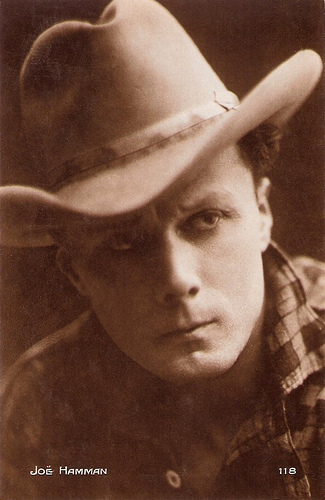
Joë Hamman . French postcard by Editions Cinémagazine, no. 118.
Exotic Male Antagonists
After the First World War, Gaston Modot got more interested in acting in the artistic intellectual films of the so-called French Impressionism, such as Germaine Dulac’s La Fête espagnole/Spanish Fiesta (1919) and Louis Delluc’s Fièvre/Fever (1921), both with Ève Francis .
With Max Linder , Modot played in Abel Gance ’s horror comedy Au secours!/Help! (1924).
He mostly acted though in more conventional productions such as La terre du diable/The land of the devil (Luitz-Morat, 1922), shot around Mount Vesuvius in Italy. It was one of the rare films in which Modot was the male protagonist of the film. He played the Italian shepherd Ascanio who keeps Betsy, a British woman, at his home and involves the demon.
Other examples are Mathias Sandorf (Henri Fescourt, 1921) with Romuald Joubé , the serial Les Mystères de Paris/Mysteries of Paris (Charles Burguet, 1922), Le miracle des loups/Miracle of the Wolves (Raymond Bernard, 1924), Carmen (Jacques Feyder, 1926) with Raquel Meller , La merveilleuse vie de Jeanne d’Arc, fille de Lorraine/Saint Joan the Maid (Marco de Gastyne, 1927-1929), and, again, Monte Christo (Henri Fescourt, 1929) with Jean Angelo .
Modot often played exotic male antagonists in orientalist dramas such as La sultane de l'amour/The Sultan of Love (Charles Le Burguet, René Le Somptier, 1919), A l'horizon du Sud/On the horizon of the South (Marco de Gastyne, 1923), and Sous le ciel d'orient/Under the sky of the Orient (Fred Leroy-Granville, 1927).
In the late 1920s Modot performed in several German-French co-productions such as Geheimnisse des Orients/Secrets of the Orient (Alexander Volkoff, 1928) with Iván Petrovich , and Die Stadt der tausend Freuden/The City of Thousand Joys (Carmine Gallone, 1928) with Paul Richter .
Opposite Lya Lys as The Woman, Modot became famous for his part as The Man in the Surrealist and anti-establishment film L'Âge d'Or/The Golden Age (1930) by Luis Buñuel and Salvador Dali.
When shown at the Parisian art house Studio 28, right-wing fanatics destroyed the film screen and the Surrealist paintings in the lobby of the cinema.
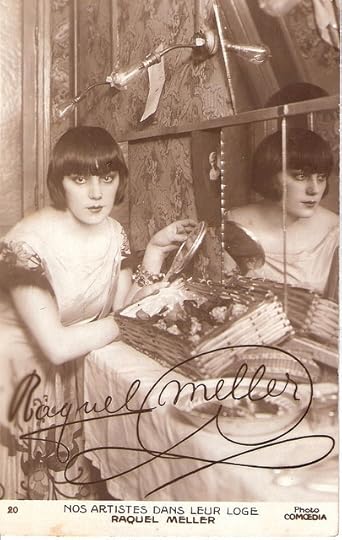
Raquel Meller . French postcard by Ed. Art de Comoedia, quotidien des theatres, in the series Nos Artistes Dans Leur Loge, no. 20 . Concessionnaire: Editions Lafayette, Paris. Photo: Comoedia.
In The Left Wing Camp
In 1930 Gaston Modot had his first role in sound cinema with René Clair's Sous les toits de Paris/Under the Roofs of Paris (1930), starring Albert Préjean .
When in the 1930s the situation politicized in France, Modot was clearly in the left wing camp.
He played Peachum, king of the beggars, in the French film adaptation of Bertolt Brecht’s Threepenny Opera, L’Opéra de quat’sous (G.W. Pabst, 1931); a soldier in the Spanish Civil War drama La Bandera/Escape from Yesterday (Julien Duvivier, 1935) starring Jean Gabin ; and Gaston Ravaux in the communist drama Le temps des cérises/The Time of the Cherries (Jean-Paul Dreyfus = Jean-Paul Le Chanois, 1937).
He also joined the left wing cast of Jean Renoir’s collective production La vie est à nous/The People of France (1936), a political pamphlet funded by the Communist Party to support the electoral campaign of the Popular Front.
Modot became a regular of Renoir’s cast, performing in his First World War drama La grande illusion/Grand Illusion (1937) and his French revolution drama La Marseillaise (1937-1938).
Unforgettable he was in Renoir’s La règle du jeu/The Rules of the Game (Jean Renoir, 1939) as Schumacher, the explosive gamekeeper who chases Marceau, lover (Carette) of his wife Lisette ( Paulette Dubost ), all through the villa and the garden of the rich marquis Robert ( Marcel Dalio ) and his wife Christine ( Nora Gregor ), accidentally killing an aviation hero (Roland Toutain) who happened to be Christine’s lover.
Apart from Renoir, in the 1930s Modot played also memorable parts as Firmin in Fantômas (Paul Fejos, 1932), police officer Matra in Crainquebille (Jacques Feyder, 1934) starring Tramel , and Jimmy in Pépé le Moko (Julien Duvivier, 1937) starring Jean Gabin and Mireille Balin .
During the war years, he played the blind man Fil de soie in Marcel Carné’s two-part Les enfants du paradis (1945).
During and in the immediate post-war years Modot was also co-screenwriter for a handful of films.
Memorable parts of his post-war acting career he played in Casque d’or (Jacques Becker, 1951), French Cancan (Jean Renoir, 1954) and Le testament du Dr. Cordelier/The Testament of Doctor Cordelier (Jean Renoir, 1961).
In 1962 Gaston Modot ended his career, after acting in over 300 films, both shorts and features.
Modot died in 1970 in Paris. He was 82.
Fièvre/Fever (1921). Source: RadioFilmandTV (YouTube).
Sound sequence of L'Age d'Or/The Golden Age (1930). Source: GWijthoff (YouTube).
Sources: cineressources.bifi.fr/, Wikipedia (English, German, French and Italian) and .

French postcard by Editions Cinémagazine, no. 416. Photo: Cliché Sartony.
Comedies Series and Westerns in the Camarque
French actor Gaston Modot was born in Paris in 1887. For over 50 years (1909-1962) he was active as a film actor, playing with almost all important French directors.
Modot, the son of an architect, originally was interested in painting. At the beginning of the 20th century he lived in Montmartre, meeting Picasso and Modigliani, but also writers like Blaise Cendrars.
After a try at painting he became a film set decorator, thus entering the world of cinema.
In 1909 he started to act for the Gaumont company where he was part of the gang of the Pouittes in the comical adventure films by Jean Durand.
He also often acted in the comical series with Calino and Onésime (both Ernest Bourbon) and Zigoto (Lucien Bataille), and in the late 1910s also those with Serpentin ( Marcel Levesque ).
With Joë Hamman , he performed in his western series shot in the Camargue.
During the First World War he started to combine his comic parts more and more with dramatic performances.
Examples are a supporting part as domestic (not as protagonist, as Wikipedia claims) in Mater dolorosa/Sorrowful Mother (Abel Gance, 1917), starring Emmy Lynn and Firmin Gémier, and the part of Bertuccio in Le comte de Monte Cristo/The Count of Monte Cristo (Henri Pouctal, 1914-1917), a serial in 8 episodes.

Joë Hamman . French postcard by Editions Cinémagazine, no. 118.
Exotic Male Antagonists
After the First World War, Gaston Modot got more interested in acting in the artistic intellectual films of the so-called French Impressionism, such as Germaine Dulac’s La Fête espagnole/Spanish Fiesta (1919) and Louis Delluc’s Fièvre/Fever (1921), both with Ève Francis .
With Max Linder , Modot played in Abel Gance ’s horror comedy Au secours!/Help! (1924).
He mostly acted though in more conventional productions such as La terre du diable/The land of the devil (Luitz-Morat, 1922), shot around Mount Vesuvius in Italy. It was one of the rare films in which Modot was the male protagonist of the film. He played the Italian shepherd Ascanio who keeps Betsy, a British woman, at his home and involves the demon.
Other examples are Mathias Sandorf (Henri Fescourt, 1921) with Romuald Joubé , the serial Les Mystères de Paris/Mysteries of Paris (Charles Burguet, 1922), Le miracle des loups/Miracle of the Wolves (Raymond Bernard, 1924), Carmen (Jacques Feyder, 1926) with Raquel Meller , La merveilleuse vie de Jeanne d’Arc, fille de Lorraine/Saint Joan the Maid (Marco de Gastyne, 1927-1929), and, again, Monte Christo (Henri Fescourt, 1929) with Jean Angelo .
Modot often played exotic male antagonists in orientalist dramas such as La sultane de l'amour/The Sultan of Love (Charles Le Burguet, René Le Somptier, 1919), A l'horizon du Sud/On the horizon of the South (Marco de Gastyne, 1923), and Sous le ciel d'orient/Under the sky of the Orient (Fred Leroy-Granville, 1927).
In the late 1920s Modot performed in several German-French co-productions such as Geheimnisse des Orients/Secrets of the Orient (Alexander Volkoff, 1928) with Iván Petrovich , and Die Stadt der tausend Freuden/The City of Thousand Joys (Carmine Gallone, 1928) with Paul Richter .
Opposite Lya Lys as The Woman, Modot became famous for his part as The Man in the Surrealist and anti-establishment film L'Âge d'Or/The Golden Age (1930) by Luis Buñuel and Salvador Dali.
When shown at the Parisian art house Studio 28, right-wing fanatics destroyed the film screen and the Surrealist paintings in the lobby of the cinema.

Raquel Meller . French postcard by Ed. Art de Comoedia, quotidien des theatres, in the series Nos Artistes Dans Leur Loge, no. 20 . Concessionnaire: Editions Lafayette, Paris. Photo: Comoedia.
In The Left Wing Camp
In 1930 Gaston Modot had his first role in sound cinema with René Clair's Sous les toits de Paris/Under the Roofs of Paris (1930), starring Albert Préjean .
When in the 1930s the situation politicized in France, Modot was clearly in the left wing camp.
He played Peachum, king of the beggars, in the French film adaptation of Bertolt Brecht’s Threepenny Opera, L’Opéra de quat’sous (G.W. Pabst, 1931); a soldier in the Spanish Civil War drama La Bandera/Escape from Yesterday (Julien Duvivier, 1935) starring Jean Gabin ; and Gaston Ravaux in the communist drama Le temps des cérises/The Time of the Cherries (Jean-Paul Dreyfus = Jean-Paul Le Chanois, 1937).
He also joined the left wing cast of Jean Renoir’s collective production La vie est à nous/The People of France (1936), a political pamphlet funded by the Communist Party to support the electoral campaign of the Popular Front.
Modot became a regular of Renoir’s cast, performing in his First World War drama La grande illusion/Grand Illusion (1937) and his French revolution drama La Marseillaise (1937-1938).
Unforgettable he was in Renoir’s La règle du jeu/The Rules of the Game (Jean Renoir, 1939) as Schumacher, the explosive gamekeeper who chases Marceau, lover (Carette) of his wife Lisette ( Paulette Dubost ), all through the villa and the garden of the rich marquis Robert ( Marcel Dalio ) and his wife Christine ( Nora Gregor ), accidentally killing an aviation hero (Roland Toutain) who happened to be Christine’s lover.
Apart from Renoir, in the 1930s Modot played also memorable parts as Firmin in Fantômas (Paul Fejos, 1932), police officer Matra in Crainquebille (Jacques Feyder, 1934) starring Tramel , and Jimmy in Pépé le Moko (Julien Duvivier, 1937) starring Jean Gabin and Mireille Balin .
During the war years, he played the blind man Fil de soie in Marcel Carné’s two-part Les enfants du paradis (1945).
During and in the immediate post-war years Modot was also co-screenwriter for a handful of films.
Memorable parts of his post-war acting career he played in Casque d’or (Jacques Becker, 1951), French Cancan (Jean Renoir, 1954) and Le testament du Dr. Cordelier/The Testament of Doctor Cordelier (Jean Renoir, 1961).
In 1962 Gaston Modot ended his career, after acting in over 300 films, both shorts and features.
Modot died in 1970 in Paris. He was 82.
Fièvre/Fever (1921). Source: RadioFilmandTV (YouTube).
Sound sequence of L'Age d'Or/The Golden Age (1930). Source: GWijthoff (YouTube).
Sources: cineressources.bifi.fr/, Wikipedia (English, German, French and Italian) and .
Published on October 16, 2013 23:00
October 15, 2013
Richard Berry
Richard Berry (1950) is a French actor, film director and screenwriter. He has appeared in nearly 100 films since 1972.
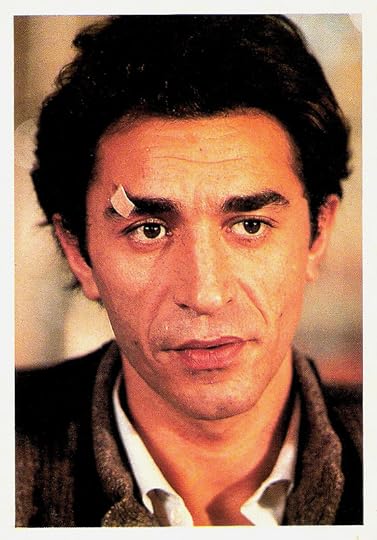
French postcard by Editions Humour à la Carte, Paris, no. ST-62.
My First Love
Richard Berry was born in Paris in 1950. His brother Philippe Berry is a sculptor and sometimes actor.
Richard entered the Conservatoire National Supérieur d'Art Dramatique – CNSAD (French National Academy of Dramatic Arts) in 1969, and joined the Comédie Française in 1973.
He started his film career with a bit part in the drama Absences répétées/Repeated Absences (Guy Gilles, 1972).
In 1978 he had his breakthrough opposite Anouk Aimée in the romantic drama Mon premier amour/My first love (Élie Chouraqui, 1978). It is the sentimental story of the relationship between a lovely mother and her 20-year-old son who never really knew her. When he learns that she is dying of leukaemia, he tries to get to know her.
In the crime drama Le Grand Pardon (Alexandre Arcady, 1982), he played the son of Jewish gangster Roger Hanin.
Another success was La Balance/The Nark (Bob Swaim, 1982) starring Nathalie Baye and Philippe Léotard. It won the César Award for Best Film, Best Actor and Best Actress, and was nominated for Most Promising Actor (twice), Best Director, Best Writing - Original and Best Editing. The film had more than 4 million admissions in France becoming the 5th highest grossing film of the year.
Berry co-starred with Dominique Sanda and Danielle Darrieux in Une chambre en ville/A Room in Town (Jacques Demy, 1982), a musical in which every line of dialogue is sung.
Eleanor Mannikka at AllMovie : “Enhanced by excellent choreography, this film still did poorly at the box office when it was first released. In order to save it and encourage audiences to see it for its own merits, 76 French critics took out an ad in Le Monde to promote the film, and some critics said that if this movie failed, so would all of French cinema. Perhaps it is not surprising then that Chambre En Ville won the French Critics' Prix Méliès in 1982.”
Other films included the thrillers La Garce/The Bitch (Christine Pascal, 1984) starring Isabelle Huppert , and Lune de miel/Honeymoon (Patrick Jamain, 1985) with Nathalie Baye.
He had a big role next to Jean-Louis Trintignant and Anouk Aimée in Un homme et une femme, 20 ans déjà/A Man and a Woman: 20 Years Later (Claude Lelouch, 1986) a sequel to Lelouch's classic Un homme et une femme (1966).
With Isabelle Huppert , he also appeared in the French–Yugoslavian drama film Seobe/Migrations (Aleksandar Petrović, 1988).
And he played painter Amedeo Modigliani in Modí (Franco Brogi Taviani, 1989).
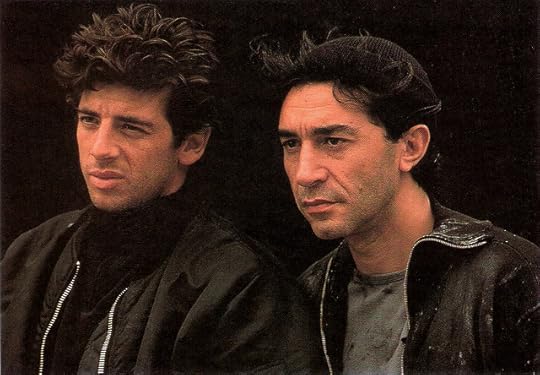
French postcard by Editions F. Nugeron. Photo: publicity still for L'Union Sacrée/Brothers in Arms (Alexandre Arcady, 1989).
Gay Comedy
During the 1990s, Richard Berry starred in a stream of interesting French films.
He played the lead in the drama L'entraînement du champion avant la course/The drive champion before the race (Bernard Favre, 1991), which was screened in the Un Certain Regard section at the 1991 Cannes Film Festival.
He played a banker with a criminal father (Roger Hanin) in the sequel Le Grand Pardon II/Day of Atonement (Alexandre Arcady, 1992). The film, shot in France and the US, also features the American film stars Christopher Walken, Jill Clayburgh and Jennifer Beals.
He co-starred with Claudia Cardinale and Omar Sharif in 588 rue paradis/Mother (1992), a semi-autobiographical film written and directed by French-Armenian filmmaker Henri Verneuil.
He received a César nomination for his lead in the French-Swiss drama Le Petit Prince a Dit/And the Little Prince Said (Christine Pascal, 1992) which follows an estranged Swiss couple (Berry and Anémone) who re-evaluate their relationship with the discovery of their daughter's terminal illness.
Then he played the title role in the French-Belgian drama Le joueur de violon/The Violin Player (Charles Van Damme, 1994), which was entered into the 1994 Cannes Film Festival.
Another critical success was L'Appât/The Bait (Bertrand Tavernier, 1995) about two boys and a girl who commit a murder, with the girl acting as a 'bait'. The film is based on the 1990 book by Morgan Sportès, which is in turn based on a true event in 1984. The film won the Golden Bear Award at the 45th Berlin International Film Festival.
Next he appeared with Patrick Timsit in the gay comedy Pédale douce/Soft Pedal (Gabriel Aghion, 1996), for which their co-star Fanny Ardant won the 1997 César Award for Best Actress.
Timsit directed him in Quasimodo d'El Paris (Patrick Timsit, 1999), a comedic adaptation of the novel Notre-Dame de Paris (The Hunchback of Notre Dame) by Victor Hugo.
He co-starred with Jacqueline Bisset in the dramedy Les Gens qui s'aiment/People Who Love Each Other (Jean-Charles Tacchella, 1999).
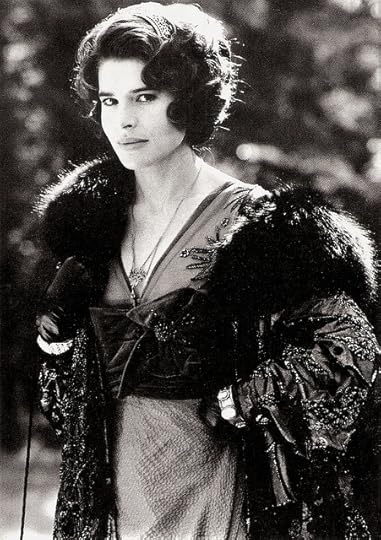
Fanny Ardant . French postcard by Humour a la Carte, Paris, no. 3713.
A Pain in the Ass
Richard Berry continued to be a major French star in the new Millennium.
He starred in the comedy 15 Août/15 August (Patrick Alessandrin, 2001) about several middle aged men who have a crisis on their hands when their wives depart leaving them to look after the boisterous kids.
berry was the treacherous boss of Jean-Pierre Darroussin in Ah! Si j'étais riche/If I Were a Rich Man (Gérard Bitton, Michel Munz, 2002).
He co-starred in the comedy-crime caper Tais toi!/Shut up! (Francis Veber, 2003) starring Jean Reno and Gérard Depardieu .
His film Moi César, 10 ans 1/2, 1m39/I, Cesar (Richard Berry, 2003) was inspired by his childhood which was sometimes painful.
Berry also directed the mystery La Boîte noire/The Black Box (2005), which he also wrote with Éric Assous, adapted from a novella by Tonino Benacquista. The film starred José Garcia and Marion Cotillard.
He had a supporting part in the comedy La doublure/The Valet (Francis Veber, 2006).
In 2008, he reunited with Patrick Timsit for a remake of the black comedy L' Emmerdeur/A Pain In The Ass (Édouard Molinaro, 1973) about the unlikely friendship between a hitman (in 1973 Lino Ventura ) and a suicidal guy (in 1973 Jacques Brel ).
The new L' Emmerdeur (2008) was directed by farce master Francis Veber, who had also written the original version. Berry himself directed the action thriller L'immortel/22 Bullets (Richard Berry, 2009) with Jean Reno, based on the novel L'Immortel by Franz-Olivier Giesbert.
Richard Berry was married three times. First with actress Jessica Forde and later with Jeane Manson. Since 2009 he is married to actress Pascale Praise.
He is the father of the actresses Coline and Josephine Berry.
His newest film is Avant l'hiver/Winter Rose (Philippe Claudel, 2013) with Daniel Auteuil and Kristin Scott Thomas.
Richard Berry sings Visiteur (1984). Source: Bultofrance (YouTube).
Australian trailer L' Emmerdeur/A Pain In The Ass (1980). Source: Shar mill (YouTube).
Sources: Eleanor Mannikka (AllMovie), Wikipedia (English and French), AllMovie and .

French postcard by Editions Humour à la Carte, Paris, no. ST-62.
My First Love
Richard Berry was born in Paris in 1950. His brother Philippe Berry is a sculptor and sometimes actor.
Richard entered the Conservatoire National Supérieur d'Art Dramatique – CNSAD (French National Academy of Dramatic Arts) in 1969, and joined the Comédie Française in 1973.
He started his film career with a bit part in the drama Absences répétées/Repeated Absences (Guy Gilles, 1972).
In 1978 he had his breakthrough opposite Anouk Aimée in the romantic drama Mon premier amour/My first love (Élie Chouraqui, 1978). It is the sentimental story of the relationship between a lovely mother and her 20-year-old son who never really knew her. When he learns that she is dying of leukaemia, he tries to get to know her.
In the crime drama Le Grand Pardon (Alexandre Arcady, 1982), he played the son of Jewish gangster Roger Hanin.
Another success was La Balance/The Nark (Bob Swaim, 1982) starring Nathalie Baye and Philippe Léotard. It won the César Award for Best Film, Best Actor and Best Actress, and was nominated for Most Promising Actor (twice), Best Director, Best Writing - Original and Best Editing. The film had more than 4 million admissions in France becoming the 5th highest grossing film of the year.
Berry co-starred with Dominique Sanda and Danielle Darrieux in Une chambre en ville/A Room in Town (Jacques Demy, 1982), a musical in which every line of dialogue is sung.
Eleanor Mannikka at AllMovie : “Enhanced by excellent choreography, this film still did poorly at the box office when it was first released. In order to save it and encourage audiences to see it for its own merits, 76 French critics took out an ad in Le Monde to promote the film, and some critics said that if this movie failed, so would all of French cinema. Perhaps it is not surprising then that Chambre En Ville won the French Critics' Prix Méliès in 1982.”
Other films included the thrillers La Garce/The Bitch (Christine Pascal, 1984) starring Isabelle Huppert , and Lune de miel/Honeymoon (Patrick Jamain, 1985) with Nathalie Baye.
He had a big role next to Jean-Louis Trintignant and Anouk Aimée in Un homme et une femme, 20 ans déjà/A Man and a Woman: 20 Years Later (Claude Lelouch, 1986) a sequel to Lelouch's classic Un homme et une femme (1966).
With Isabelle Huppert , he also appeared in the French–Yugoslavian drama film Seobe/Migrations (Aleksandar Petrović, 1988).
And he played painter Amedeo Modigliani in Modí (Franco Brogi Taviani, 1989).

French postcard by Editions F. Nugeron. Photo: publicity still for L'Union Sacrée/Brothers in Arms (Alexandre Arcady, 1989).
Gay Comedy
During the 1990s, Richard Berry starred in a stream of interesting French films.
He played the lead in the drama L'entraînement du champion avant la course/The drive champion before the race (Bernard Favre, 1991), which was screened in the Un Certain Regard section at the 1991 Cannes Film Festival.
He played a banker with a criminal father (Roger Hanin) in the sequel Le Grand Pardon II/Day of Atonement (Alexandre Arcady, 1992). The film, shot in France and the US, also features the American film stars Christopher Walken, Jill Clayburgh and Jennifer Beals.
He co-starred with Claudia Cardinale and Omar Sharif in 588 rue paradis/Mother (1992), a semi-autobiographical film written and directed by French-Armenian filmmaker Henri Verneuil.
He received a César nomination for his lead in the French-Swiss drama Le Petit Prince a Dit/And the Little Prince Said (Christine Pascal, 1992) which follows an estranged Swiss couple (Berry and Anémone) who re-evaluate their relationship with the discovery of their daughter's terminal illness.
Then he played the title role in the French-Belgian drama Le joueur de violon/The Violin Player (Charles Van Damme, 1994), which was entered into the 1994 Cannes Film Festival.
Another critical success was L'Appât/The Bait (Bertrand Tavernier, 1995) about two boys and a girl who commit a murder, with the girl acting as a 'bait'. The film is based on the 1990 book by Morgan Sportès, which is in turn based on a true event in 1984. The film won the Golden Bear Award at the 45th Berlin International Film Festival.
Next he appeared with Patrick Timsit in the gay comedy Pédale douce/Soft Pedal (Gabriel Aghion, 1996), for which their co-star Fanny Ardant won the 1997 César Award for Best Actress.
Timsit directed him in Quasimodo d'El Paris (Patrick Timsit, 1999), a comedic adaptation of the novel Notre-Dame de Paris (The Hunchback of Notre Dame) by Victor Hugo.
He co-starred with Jacqueline Bisset in the dramedy Les Gens qui s'aiment/People Who Love Each Other (Jean-Charles Tacchella, 1999).

Fanny Ardant . French postcard by Humour a la Carte, Paris, no. 3713.
A Pain in the Ass
Richard Berry continued to be a major French star in the new Millennium.
He starred in the comedy 15 Août/15 August (Patrick Alessandrin, 2001) about several middle aged men who have a crisis on their hands when their wives depart leaving them to look after the boisterous kids.
berry was the treacherous boss of Jean-Pierre Darroussin in Ah! Si j'étais riche/If I Were a Rich Man (Gérard Bitton, Michel Munz, 2002).
He co-starred in the comedy-crime caper Tais toi!/Shut up! (Francis Veber, 2003) starring Jean Reno and Gérard Depardieu .
His film Moi César, 10 ans 1/2, 1m39/I, Cesar (Richard Berry, 2003) was inspired by his childhood which was sometimes painful.
Berry also directed the mystery La Boîte noire/The Black Box (2005), which he also wrote with Éric Assous, adapted from a novella by Tonino Benacquista. The film starred José Garcia and Marion Cotillard.
He had a supporting part in the comedy La doublure/The Valet (Francis Veber, 2006).
In 2008, he reunited with Patrick Timsit for a remake of the black comedy L' Emmerdeur/A Pain In The Ass (Édouard Molinaro, 1973) about the unlikely friendship between a hitman (in 1973 Lino Ventura ) and a suicidal guy (in 1973 Jacques Brel ).
The new L' Emmerdeur (2008) was directed by farce master Francis Veber, who had also written the original version. Berry himself directed the action thriller L'immortel/22 Bullets (Richard Berry, 2009) with Jean Reno, based on the novel L'Immortel by Franz-Olivier Giesbert.
Richard Berry was married three times. First with actress Jessica Forde and later with Jeane Manson. Since 2009 he is married to actress Pascale Praise.
He is the father of the actresses Coline and Josephine Berry.
His newest film is Avant l'hiver/Winter Rose (Philippe Claudel, 2013) with Daniel Auteuil and Kristin Scott Thomas.
Richard Berry sings Visiteur (1984). Source: Bultofrance (YouTube).
Australian trailer L' Emmerdeur/A Pain In The Ass (1980). Source: Shar mill (YouTube).
Sources: Eleanor Mannikka (AllMovie), Wikipedia (English and French), AllMovie and .
Published on October 15, 2013 23:00
Paul van Yperen's Blog
- Paul van Yperen's profile
- 13 followers
Paul van Yperen isn't a Goodreads Author
(yet),
but they
do have a blog,
so here are some recent posts imported from
their feed.



